Paul van Yperen's Blog, page 347
May 2, 2016
Margaret Leahy
Margaret Leahy (1902–1967) was a British actress. After winning a beauty contest, Leahy went on to make only one film in her very short-lived film career.
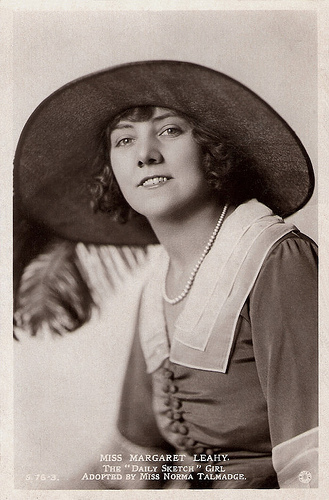
British postcard by Rotary Photo, London, no. 5.76. 3. Caption: "The Daily Sketch girl. Adopted by Miss Norma Talmadge."
The most ravishing girl in England
Margaret Leahy was born in London, Great Britain, in 1902. At 18 years of age, she set up a costume shop in Brixton, England designing women's clothing and modelling her designs for interested buyers.
In 1922, a starring role in a major Hollywood film was offered by the Daily Sketch newspaper in a grand and widely publicised film star competition. The genesis of the idea came from the American company First National Pictures, with their two leading stars, Norma and Constance Talmadge. Joe Schenck, chairman of First National and Norma Talmadge's husband, probably proposed the idea, but at the encouragement of Sir Edward Hulton, the owner of the popular newspapers the Daily Sketch and the Evening Standard.
The competition was to find a British actress to play second lead in Norma Talmadge's forthcoming film Within The Law. Norma and Constance Talmadge themselves would come to Stoll Film Studios (where the screen tests were to be made) and select the winner. The contestants reputably numbered nearly 80,000 and the competition resulted in three girls thought suitable: Katherine Campbell, the French Agnès Souret and Leahy.
Norma Talmadge stated that Leahy was "the most ravishing girl in England" and had "a perfect film face ... splendid eyes, a supple body, and convincing expressions ... her features are so perfect, and her character so distinctive!" Prior to depart to Hollywood, Leahy toured several major cities in Europe and was greeted with hundreds of cheering fans and photographers as the new film star that was about to be born.
In November of 1922, Margaret Leahy sailed on the 'Aquitania' for America. She arrived in New York on 3 December and was greeted by a huge crowd which included Norma and Constance Talmadge, director D.W. Griffith, Mae Murray and Marion Davies. After a short stay in New York, Leahy boarded the train for Hollywood with the Talmadges. When she arrived in Hollywood she was met by Charlie Chaplin and Mary Pickford.
Everyone in Britain was anxious to know how she got on. Postcards of her were put on sale, and the Daily Sketch commissioned her to dictate a diary of her experiences. She began working with director Frank Lloyd who was going to make her a 'star.' Although it was said by her publicity that the young beauty queen had acted in English and French films in Europe, this proved to be highly untrue. Lloyd had her dismissed from Within the Law (1923). The silent film was supposed to be Leahy's big film debut, but director Lloyd claimed that the actress could do nothing that an actress was supposed to be able to do. The part of Aggie Lynch in Within The Law went to American actress Eileen Percy.

British postcard by Rotary Photo, London, no. 5.76. 6. Caption: "The Daily Sketch girl. Adopted by Miss Norma Talmadge."
WAMPAS Baby Star
In 1923, Margaret Leahy was selected as one of thirteen WAMPAS Baby Stars. The WAMPAS Baby Stars was a promotional campaign sponsored by the United States Western Association of Motion Picture Advertisers, which honoured 13 young actresses each year whom they believed to be on the threshold of movie stardom. The campaign ran from 1922 to 1934.
Leahy was probably selected due to the help of producer Joseph Schenck, who had signed a three-year contract with the girl. Following this, Schenck believed it did not take much for an actress to be a comedian, and handed Margaret over to his brother-in-law Buster Keaton to appear in his next comedy, the silent feature Three Ages (Edward F. Cline, Buster Keaton, 1923).
Film historian Luke Mc Kernan writes about the film at BusterKeaton.com : "A comic history of love in prehistoric, Roman and modern times, it has Keaton fighting his rival, Wallace Beery, over a girl [Leahy] and winning her against the odds each time. Allegedly parodying Intolerance, it is really three sketches strung together rather than a true feature, but it is still highly amusing (especially in the Stone Age sequence) and boasts some breathtaking stunts."
Leahy's only film did absolutely nothing to improve her already crumbling film career. After the film finished shooting, there were no attempts to put her in any other films as she was labelled as being untalented and incapable of learning how to act. In the press, Leahy's role was not given much attention, and she never acted again. She went so far as to sue Joseph Schenck for $50,000 for breach of contract and injured feelings.
Leahy chose to remain in California and get married, instead of returning to England. She later became an interior decorator for Bullock's department store, going by the name of Marion Meade. She grew to despise the movie industry and burnt all her scrapbooks. In 1967, Margaret Leahy apparently committed suicide in Los Angeles, California, at the age of 64.
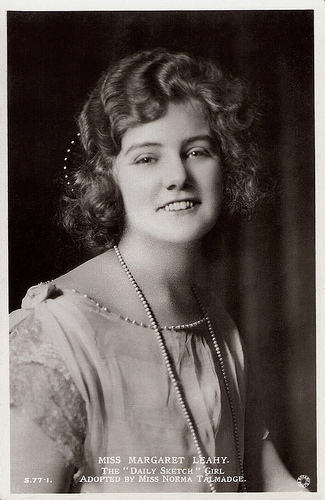
British postcard by Rotary Photo, London, no. 5.77. 1. Caption: "The Daily Sketch girl. Adopted by Miss Norma Talmadge."
Sources: Luke McKernan (Buster Keaton.com), Wikipedia and .

British postcard by Rotary Photo, London, no. 5.76. 3. Caption: "The Daily Sketch girl. Adopted by Miss Norma Talmadge."
The most ravishing girl in England
Margaret Leahy was born in London, Great Britain, in 1902. At 18 years of age, she set up a costume shop in Brixton, England designing women's clothing and modelling her designs for interested buyers.
In 1922, a starring role in a major Hollywood film was offered by the Daily Sketch newspaper in a grand and widely publicised film star competition. The genesis of the idea came from the American company First National Pictures, with their two leading stars, Norma and Constance Talmadge. Joe Schenck, chairman of First National and Norma Talmadge's husband, probably proposed the idea, but at the encouragement of Sir Edward Hulton, the owner of the popular newspapers the Daily Sketch and the Evening Standard.
The competition was to find a British actress to play second lead in Norma Talmadge's forthcoming film Within The Law. Norma and Constance Talmadge themselves would come to Stoll Film Studios (where the screen tests were to be made) and select the winner. The contestants reputably numbered nearly 80,000 and the competition resulted in three girls thought suitable: Katherine Campbell, the French Agnès Souret and Leahy.
Norma Talmadge stated that Leahy was "the most ravishing girl in England" and had "a perfect film face ... splendid eyes, a supple body, and convincing expressions ... her features are so perfect, and her character so distinctive!" Prior to depart to Hollywood, Leahy toured several major cities in Europe and was greeted with hundreds of cheering fans and photographers as the new film star that was about to be born.
In November of 1922, Margaret Leahy sailed on the 'Aquitania' for America. She arrived in New York on 3 December and was greeted by a huge crowd which included Norma and Constance Talmadge, director D.W. Griffith, Mae Murray and Marion Davies. After a short stay in New York, Leahy boarded the train for Hollywood with the Talmadges. When she arrived in Hollywood she was met by Charlie Chaplin and Mary Pickford.
Everyone in Britain was anxious to know how she got on. Postcards of her were put on sale, and the Daily Sketch commissioned her to dictate a diary of her experiences. She began working with director Frank Lloyd who was going to make her a 'star.' Although it was said by her publicity that the young beauty queen had acted in English and French films in Europe, this proved to be highly untrue. Lloyd had her dismissed from Within the Law (1923). The silent film was supposed to be Leahy's big film debut, but director Lloyd claimed that the actress could do nothing that an actress was supposed to be able to do. The part of Aggie Lynch in Within The Law went to American actress Eileen Percy.

British postcard by Rotary Photo, London, no. 5.76. 6. Caption: "The Daily Sketch girl. Adopted by Miss Norma Talmadge."
WAMPAS Baby Star
In 1923, Margaret Leahy was selected as one of thirteen WAMPAS Baby Stars. The WAMPAS Baby Stars was a promotional campaign sponsored by the United States Western Association of Motion Picture Advertisers, which honoured 13 young actresses each year whom they believed to be on the threshold of movie stardom. The campaign ran from 1922 to 1934.
Leahy was probably selected due to the help of producer Joseph Schenck, who had signed a three-year contract with the girl. Following this, Schenck believed it did not take much for an actress to be a comedian, and handed Margaret over to his brother-in-law Buster Keaton to appear in his next comedy, the silent feature Three Ages (Edward F. Cline, Buster Keaton, 1923).
Film historian Luke Mc Kernan writes about the film at BusterKeaton.com : "A comic history of love in prehistoric, Roman and modern times, it has Keaton fighting his rival, Wallace Beery, over a girl [Leahy] and winning her against the odds each time. Allegedly parodying Intolerance, it is really three sketches strung together rather than a true feature, but it is still highly amusing (especially in the Stone Age sequence) and boasts some breathtaking stunts."
Leahy's only film did absolutely nothing to improve her already crumbling film career. After the film finished shooting, there were no attempts to put her in any other films as she was labelled as being untalented and incapable of learning how to act. In the press, Leahy's role was not given much attention, and she never acted again. She went so far as to sue Joseph Schenck for $50,000 for breach of contract and injured feelings.
Leahy chose to remain in California and get married, instead of returning to England. She later became an interior decorator for Bullock's department store, going by the name of Marion Meade. She grew to despise the movie industry and burnt all her scrapbooks. In 1967, Margaret Leahy apparently committed suicide in Los Angeles, California, at the age of 64.

British postcard by Rotary Photo, London, no. 5.77. 1. Caption: "The Daily Sketch girl. Adopted by Miss Norma Talmadge."
Sources: Luke McKernan (Buster Keaton.com), Wikipedia and .
Published on May 02, 2016 22:00
May 1, 2016
Karina Bell
Charming Danish actress Karina Bell (1898-1979) was the most popular female star of the Nordisk Film Kompagni in the 1920s. The blond and slim actress was the beauty ideal of her generation. She also appeared in silent German and Swedish films. In later life she became the CEO of a Danish brewery.
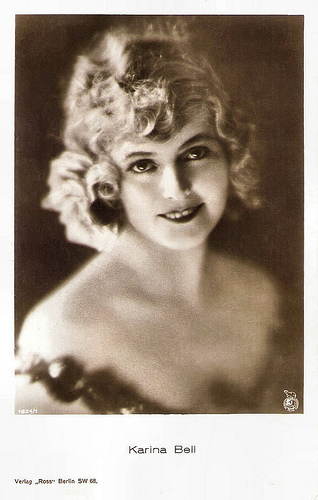
German postcard by Ross Verlag, no. 1624/1, 1927-1928. Photo: Nordisk Film. Publicity still for Klovnen/The Clown (A.W. Sandberg, 1926).
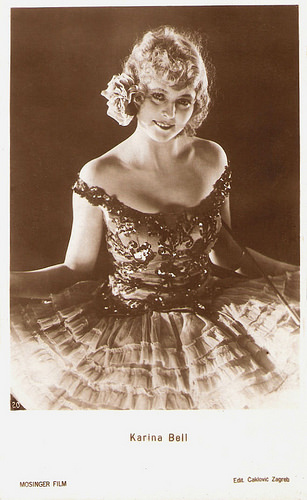
Yugoslavian postcard by Edit. Cakovic, Zagreb, no. 3747/1. Photo: Mosinger Film. Publicity still for Klovnen/The Clown (A.W. Sandberg, 1926).
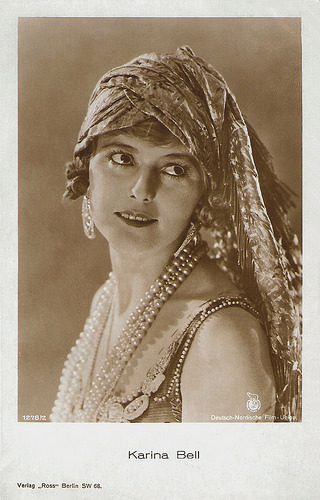
German postcard by Ross Verlag, no. 1278/2, 1927-1928. Photo: Nordisk Film / Deutsch-Nordische Film-Union. Publicity still for Maharadjahens yndlingshustru III/The Maharaja's Favourite Wife III (A.W. Sandberg, 1926).
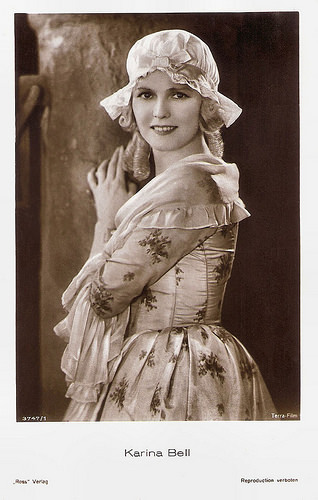
German postcard by Ross Verlag, no. 3747/1, 1928-1929. Photo: Terrra Film. Publicity still for Revolutionshochzeit/The Last Night (A.W. Sandberg, 1928).
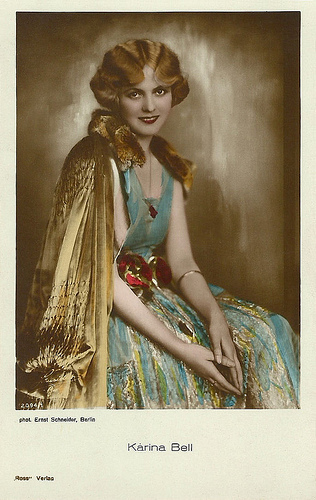
German postcard by Ross Verlag, no. 2094/1, 1927-1928. Photo: Ernst Schneider, Berlin. Collection: Didier Hanson.
Nordisk
Karina Bell was born Karina Parkov in Hellerup, Denmark, in 1898. She was the daughter of Hans Peter Hansen and Anette Marie Nielsen. She followed lessons at the ballet school of Emilie Walbom and at age 21, she made her stage debut with the leading role in Tornerose (Sleeping Beauty) (1919) at Det nye Teater (The New Theater).
Soon her first film appearance followed in Blade af Satans Bog/Leaves from Satan's Book (1919, released in 1921) by the now legendary director Carl Theodor Dreyer. Next she appeared in the Swedish production En ung mans väg/A young man's road (Carl Barcklind, 1919) opposite Philip Bech.
Bell also played in Benjamin Christensen’s presumed lost film Helgeninderne/Helge Indians (1921) and in his famous fictionalized documentary Häxan/Häxan: Witchcraft Through the Ages (1922), showing the evolution of witchcraft, from its pagan roots to its confusion with hysteria in modern Europe.
Her breakthrough was the Charles Dickens adaptation David Copperfield (A.W. Sandberg, 1922). Anders Wilhelm Sandberg was between 1916 and 1926 the leading director at the Nordisk studio. Karina Bell would star in a string of 15 films by Sandberg.
Together they would also make for Nordisk Paa Slaget 12/Twelve O'Clock (1923), Den Sidste dans/The Last Dance (1923), the comedy Kaerlighedsoen/Love Island (1924) with Gunnar Tolnaes, and Wienerbarnet (1924).
She also played the title role in another Dickens adaptation Lille Dorrit/Little Dorrit (A.W. Sandberg, 1924), with Frederik Jensen. Other films by Sandberg were Kan kvinder fejle?/Can women fail? (1924), Morænen/Moraine (1924), Min Ven Privatdetektiven/My Friend, the Private Detective (1924), Fra Piazza del Popolo/Mists of the Past (1925), and Maharajahens Yndlingshustru/The Maharadjah's Favourite Wife (1926).
Their last film for Nordisk was a remake of Sandberg's first success Klovnen/The Clown (1926), in which Karina Bell costarred with Gösta Ekman . Due to their lack of financial support to the production of Klovnen, Sandberg broke with Nordisk and he finished the film with his own funds. The film would become Karina Bell's international breakthrough.
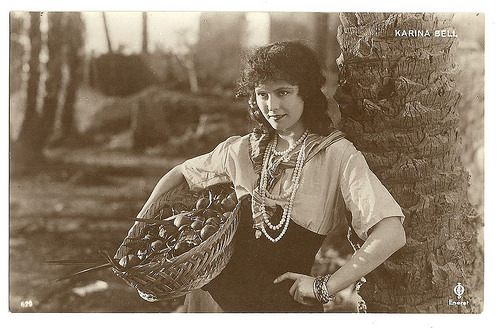
Danish postcard by Eneret, no. 629. Photo: publicity still for Kan Kvinder fejle/Can women fail? (A.W. Sandberg, 1924). This romantic comedy was partly shot in Liguria, Italy. Director A.W. Sandberg told the newspapers the film crew started filming in Trieste and at Lake Garda, but as in two days two and a half meters of snow fell, forcing the crew to withdraw to Verona and Venice. As winter still chased the crew, they moved on to Bordighera on the Italian Riviera. Here they got finally the weather they wanted, and the images were recorded under a scorching sun in 30-35 degree heat, according to Sandberg. After their return from Italym the crew shot interior shots in Valby, where among other things a set was built that envisioned 'a wealthy home'. To make the interior as compelling as possible, Sandberg almost emptied his apartment at Nørregade to provide props, such as chairs with embroidery made by his wife Elsa Fröhlich, paintings of snowy landscapes made by his father-in-law Thaulow, and an old dresser with bronze female statues by sculptor Jean René Gauguin, son of painter Paul Gauguin.
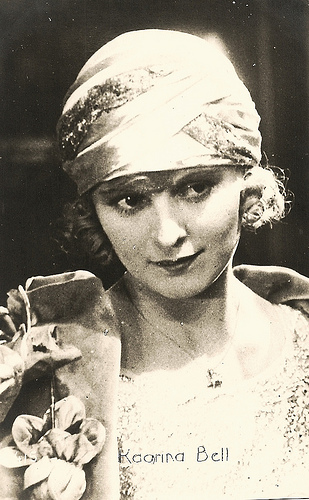
Finnish postcard by Kortcentralem, Korttikeskus, 1925. Karina Bell is written as Kaarina Bell.
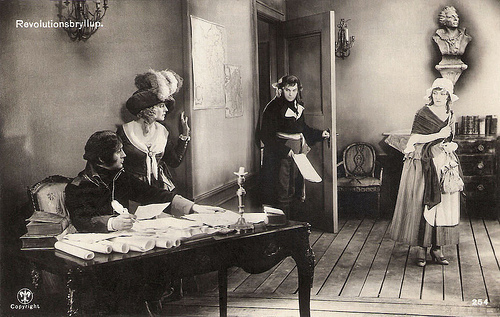
Danish postcard by Alex. Vincent's Kunstforlag, Eneret, no. 254. Photo: publicity still for Revolutionsbryllup/The Last Night (A.W. Sandberg, 1927). This was a German-Danish dramatization of Sophus Michaëlis' play Revolutionshochzeit (Revolutionary Wedding), with Gösta Ekman , Karina Bell, and Diomira Jacobini . The film was produced by Terra-Filmkunst.
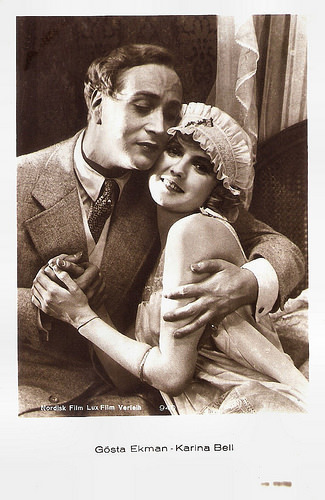
Austrian postcard by Iris Verlag, no. 949. Photo: Nordisk Film / Lux Film Verleih. Publicity still for Klovnen/The Clown (A.W. Sandberg, 1926) with Gösta Ekman .
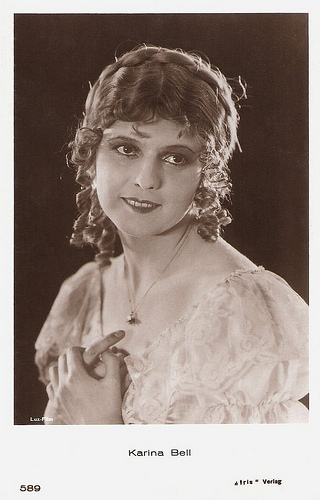
Austrian postcard by Iris Verlag, no. 589. Photo: Lux-Film.
Berlin
In 1926, Karina Bell followed A.W. Sandberg when he left for Berlin. In Germany she starred in Eheskandal in Hause Fromont jun. und Risler sen./Wedding Scandal in the House of Fromont Jr. and Risler Sr. (A.W. Sandberg, 1927) with Lucy Doraine , Nora Gregor and Fred Louis Lerch .
In the period piece Revolutionshochzeit/The Last Night (A.W. Sandberg, 1928), she co-starred with Diomiro Jacobini , Gösta Ekman and Fritz Kortner .
She also starred in Phantome des Glücks/Phantoms of Happiness (Reinhold Schünzel, 1929). She played a dancer opposite Michael Chekhov and Gaston Modot . The film was originally made as a silent, then re-released in 1930 with an added soundtrack.
After the arrival of the sound film, she returned to Denmark. She performed in theatres in Copenhagen and Oslo, and she made two sound films: Nyhavn 17/New Harbour 17 (George Schneevoigt, 1933) and one last film with A.W. Sandberg, the comedy 5 raske piger/Five Healthy Girls (1933).
In 1934 she married Knud P. Parkov, director of the Wiibroes Bryggeri (Wiibroes beer brewery), and gave up her stage and film career. When her husband died in 1949 she took over as CEO at Wiibroes under the name Karen Gudrun Louise Parkov.
Karina Bell died in Denmark in 1979, at the age of 80.
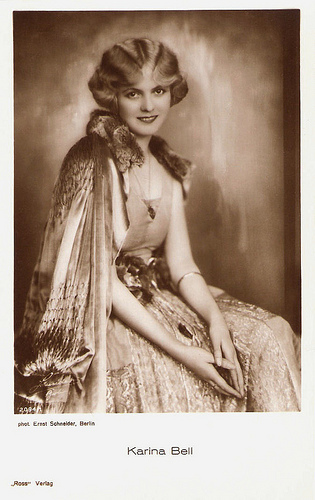
German postcard by Ross Verlag, no. 2094/1, 1927-1928. Photo: Ernst Schneider, Berlin.
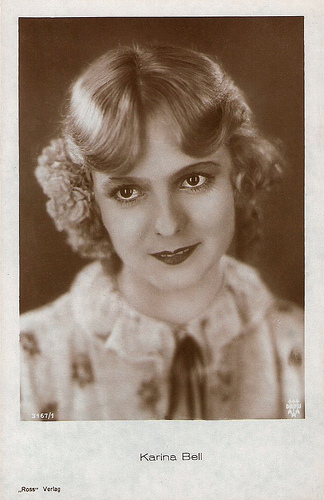
German postcard by Ross Verlag, no. 3167/1, 1927-1928. Photo: DEFU.
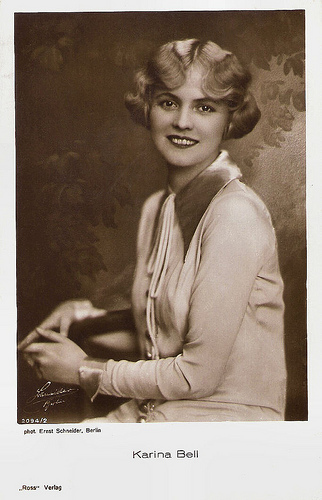
German postcard by Ross Verlag, no. 3094/2, 1927-1928. Photo: Ernst Schneider, Berlin.
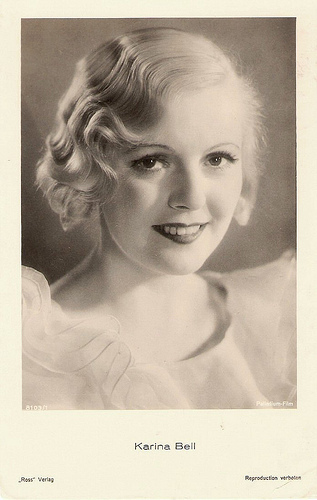
German Postcard by Ross Verlag, no. 8103/1, 1933-1934. Photo: Palladium-film.
Sources: Danish Film Institute (Danish), Den danske film database (Danish), Wikipedia (Swedish and English) and .

German postcard by Ross Verlag, no. 1624/1, 1927-1928. Photo: Nordisk Film. Publicity still for Klovnen/The Clown (A.W. Sandberg, 1926).

Yugoslavian postcard by Edit. Cakovic, Zagreb, no. 3747/1. Photo: Mosinger Film. Publicity still for Klovnen/The Clown (A.W. Sandberg, 1926).

German postcard by Ross Verlag, no. 1278/2, 1927-1928. Photo: Nordisk Film / Deutsch-Nordische Film-Union. Publicity still for Maharadjahens yndlingshustru III/The Maharaja's Favourite Wife III (A.W. Sandberg, 1926).

German postcard by Ross Verlag, no. 3747/1, 1928-1929. Photo: Terrra Film. Publicity still for Revolutionshochzeit/The Last Night (A.W. Sandberg, 1928).

German postcard by Ross Verlag, no. 2094/1, 1927-1928. Photo: Ernst Schneider, Berlin. Collection: Didier Hanson.
Nordisk
Karina Bell was born Karina Parkov in Hellerup, Denmark, in 1898. She was the daughter of Hans Peter Hansen and Anette Marie Nielsen. She followed lessons at the ballet school of Emilie Walbom and at age 21, she made her stage debut with the leading role in Tornerose (Sleeping Beauty) (1919) at Det nye Teater (The New Theater).
Soon her first film appearance followed in Blade af Satans Bog/Leaves from Satan's Book (1919, released in 1921) by the now legendary director Carl Theodor Dreyer. Next she appeared in the Swedish production En ung mans väg/A young man's road (Carl Barcklind, 1919) opposite Philip Bech.
Bell also played in Benjamin Christensen’s presumed lost film Helgeninderne/Helge Indians (1921) and in his famous fictionalized documentary Häxan/Häxan: Witchcraft Through the Ages (1922), showing the evolution of witchcraft, from its pagan roots to its confusion with hysteria in modern Europe.
Her breakthrough was the Charles Dickens adaptation David Copperfield (A.W. Sandberg, 1922). Anders Wilhelm Sandberg was between 1916 and 1926 the leading director at the Nordisk studio. Karina Bell would star in a string of 15 films by Sandberg.
Together they would also make for Nordisk Paa Slaget 12/Twelve O'Clock (1923), Den Sidste dans/The Last Dance (1923), the comedy Kaerlighedsoen/Love Island (1924) with Gunnar Tolnaes, and Wienerbarnet (1924).
She also played the title role in another Dickens adaptation Lille Dorrit/Little Dorrit (A.W. Sandberg, 1924), with Frederik Jensen. Other films by Sandberg were Kan kvinder fejle?/Can women fail? (1924), Morænen/Moraine (1924), Min Ven Privatdetektiven/My Friend, the Private Detective (1924), Fra Piazza del Popolo/Mists of the Past (1925), and Maharajahens Yndlingshustru/The Maharadjah's Favourite Wife (1926).
Their last film for Nordisk was a remake of Sandberg's first success Klovnen/The Clown (1926), in which Karina Bell costarred with Gösta Ekman . Due to their lack of financial support to the production of Klovnen, Sandberg broke with Nordisk and he finished the film with his own funds. The film would become Karina Bell's international breakthrough.

Danish postcard by Eneret, no. 629. Photo: publicity still for Kan Kvinder fejle/Can women fail? (A.W. Sandberg, 1924). This romantic comedy was partly shot in Liguria, Italy. Director A.W. Sandberg told the newspapers the film crew started filming in Trieste and at Lake Garda, but as in two days two and a half meters of snow fell, forcing the crew to withdraw to Verona and Venice. As winter still chased the crew, they moved on to Bordighera on the Italian Riviera. Here they got finally the weather they wanted, and the images were recorded under a scorching sun in 30-35 degree heat, according to Sandberg. After their return from Italym the crew shot interior shots in Valby, where among other things a set was built that envisioned 'a wealthy home'. To make the interior as compelling as possible, Sandberg almost emptied his apartment at Nørregade to provide props, such as chairs with embroidery made by his wife Elsa Fröhlich, paintings of snowy landscapes made by his father-in-law Thaulow, and an old dresser with bronze female statues by sculptor Jean René Gauguin, son of painter Paul Gauguin.

Finnish postcard by Kortcentralem, Korttikeskus, 1925. Karina Bell is written as Kaarina Bell.

Danish postcard by Alex. Vincent's Kunstforlag, Eneret, no. 254. Photo: publicity still for Revolutionsbryllup/The Last Night (A.W. Sandberg, 1927). This was a German-Danish dramatization of Sophus Michaëlis' play Revolutionshochzeit (Revolutionary Wedding), with Gösta Ekman , Karina Bell, and Diomira Jacobini . The film was produced by Terra-Filmkunst.

Austrian postcard by Iris Verlag, no. 949. Photo: Nordisk Film / Lux Film Verleih. Publicity still for Klovnen/The Clown (A.W. Sandberg, 1926) with Gösta Ekman .

Austrian postcard by Iris Verlag, no. 589. Photo: Lux-Film.
Berlin
In 1926, Karina Bell followed A.W. Sandberg when he left for Berlin. In Germany she starred in Eheskandal in Hause Fromont jun. und Risler sen./Wedding Scandal in the House of Fromont Jr. and Risler Sr. (A.W. Sandberg, 1927) with Lucy Doraine , Nora Gregor and Fred Louis Lerch .
In the period piece Revolutionshochzeit/The Last Night (A.W. Sandberg, 1928), she co-starred with Diomiro Jacobini , Gösta Ekman and Fritz Kortner .
She also starred in Phantome des Glücks/Phantoms of Happiness (Reinhold Schünzel, 1929). She played a dancer opposite Michael Chekhov and Gaston Modot . The film was originally made as a silent, then re-released in 1930 with an added soundtrack.
After the arrival of the sound film, she returned to Denmark. She performed in theatres in Copenhagen and Oslo, and she made two sound films: Nyhavn 17/New Harbour 17 (George Schneevoigt, 1933) and one last film with A.W. Sandberg, the comedy 5 raske piger/Five Healthy Girls (1933).
In 1934 she married Knud P. Parkov, director of the Wiibroes Bryggeri (Wiibroes beer brewery), and gave up her stage and film career. When her husband died in 1949 she took over as CEO at Wiibroes under the name Karen Gudrun Louise Parkov.
Karina Bell died in Denmark in 1979, at the age of 80.

German postcard by Ross Verlag, no. 2094/1, 1927-1928. Photo: Ernst Schneider, Berlin.

German postcard by Ross Verlag, no. 3167/1, 1927-1928. Photo: DEFU.

German postcard by Ross Verlag, no. 3094/2, 1927-1928. Photo: Ernst Schneider, Berlin.

German Postcard by Ross Verlag, no. 8103/1, 1933-1934. Photo: Palladium-film.
Sources: Danish Film Institute (Danish), Den danske film database (Danish), Wikipedia (Swedish and English) and .
Published on May 01, 2016 22:00
April 30, 2016
Leslie Caron
French film actress and dancer Leslie Caron (1931) was one of the most famous Hollywood stars in the 1950s. She is best known for the waif-like gamines in the classic musicals An American in Paris (1951), Lili (1953), and Gigi (1958). Since the 1960s, she is also working in the European cinema. Both onscreen and off she always shows effortless class and grace.
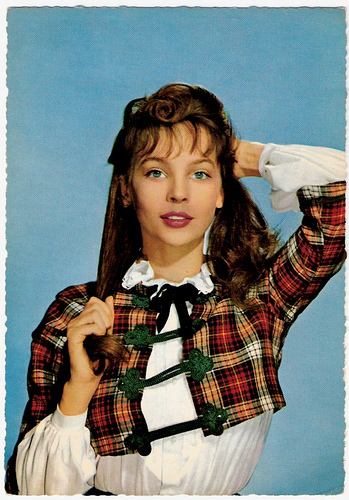
German postcard by Krüger, no. 902/34. Photo: Sam Lévin. Photo: publicity still for Gigi (Vincente Minnelli, 1958).
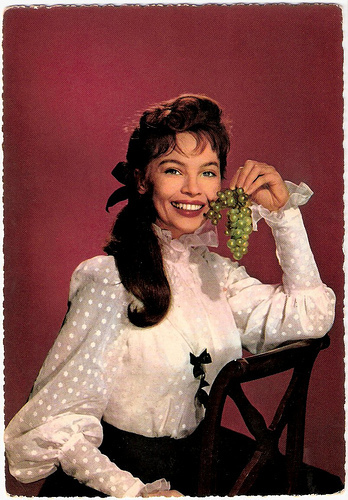
German postcard by Krüger, no. 902/35. Photo: Sam Lévin. Photo: publicity still for Gigi (Vincente Minnelli, 1958).
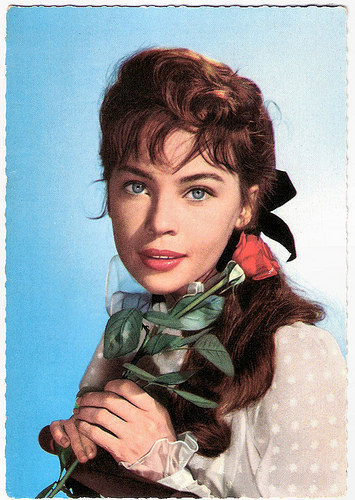
German postcard by ISV, Amsterdam, no. B 17. Photo: publicity still for Gigi (Vincente Minnelli, 1958).
Overnight Sensation
Leslie Claire Margaret Caron was born in the Paris suburb Boulogne-sur-Seine, (now Boulogne-Billancourt), France, in 1931. She was the daughter of Claude Caron, a French chemist, and Margaret Caron-Petit.
Her mother was an American dancer who briefly made it to Broadway. She had given up her career for marriage, and eventually took her own life. Her father's family was well-to-do, and in her memoir Thank Heaven... (2010), Caron describes her childhood as idyllic, divided between a townhouse in the chic Paris suburb of Neuilly-sur-Seine—with butler, chef, governess, chauffeur and maids—and a country estate in the Pyrenees.
Her mother introduced Leslie to ballet at the age of 10. The Nazi occupation of France forced her to flee to Cannes, but she returned after the war, and by the age of 16, she started her career as a ballet dancer at Roland Petit's Ballet des Champs-Élyées, a new company that was the toast of Paris.
In 1948, she became an overnight sensation as a stunning Sphinx in La Rencontre (The Encounter), David Lichine's experimental and acrobatic ballet about Oedipus and the Sphinx.
Gene Kelly saw her performance, and two years later he cast her to appear opposite him as a ballerina ingénue in An American in Paris (Vincente Minnelli, 1951). The role initially was to be danced by Cyd Charisse, but she was pregnant. So Leslie Caron could dance her way into millions of hearts of filmgoers. Her magical performance and elfin charm led to a long-term MGM contract and a string of memorable films.
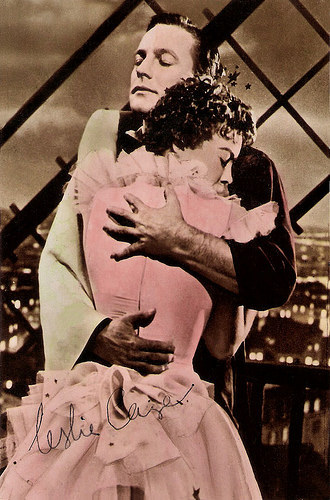
Vintage autograph card. Photo: publicity still for An American in Paris (Vincente Minnelli, 1951) with Gene Kelly.
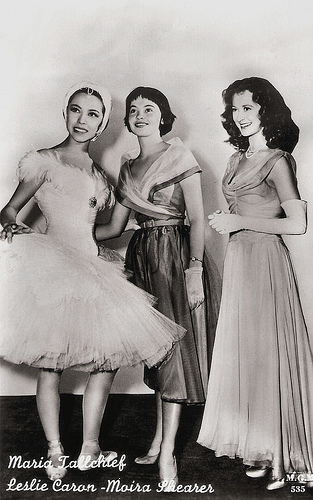
With Maria Tallchief and Moira Shearer. Vintage card no. 535. Photo: Metro-Goldwyn-Mayer.
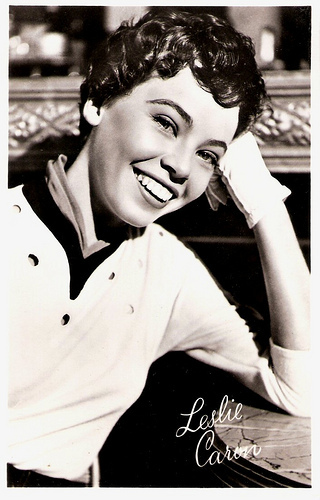
Dutch postcard by DRC, no. F 109. Photo: MGM.
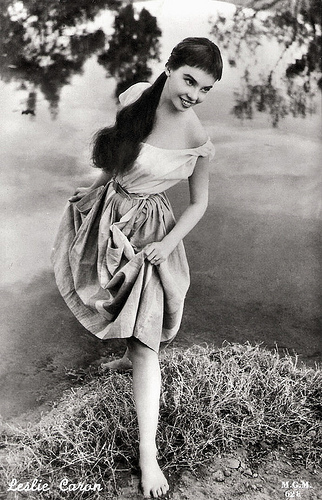
Dutch postcard by Filmphoto Service, Amsterdam, no. 628. Photo: M.G.M.
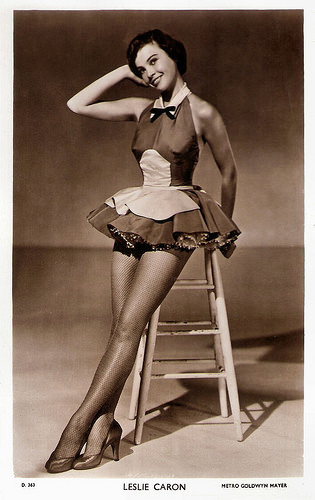
British postcard in the Picturegoer Series, London, no. D 363. Photo: Metro-Goldwyn-Mayer.
A French Lady in Hollywood
Hollywood made excellent use of Leslie Caron's ballet training and endearingly girlish screen persona. She proved a perfect partner for Fred Astaire in 20th Century-Fox's Daddy Long Legs (Jean Negulesco, 1955), and an ideal Cinderella in The Glass Slipper (Charles Walters, 1955).
Her greatest hits were the musicals Lili (Charles Walters, 1953) as a naive country girl who falls for a self-pitying puppeteer (Mel Ferrer), and Gigi (Vincente Minnelli, 1958) in which she enchantingly incarnated Colette's heroine, a young girl trained by her aunt (Isabel Jeans) and grandmother (Hermione Gingold) to become the mistress of wealthy young Gaston ( Louis Jourdan ).
Filmed on location in Paris, Gigi won several Oscars, including Best Picture. For Lili, Caron earned her first Academy Award nomination and as well a BAFTA (the British Academy award) nomination.
Both films remain enduring classics decades after their release. They helped to cement Caron's status as one of the select performers who came to fame as part of the Hollywood musical's heydays.
At the end of the 1950s, the heydays of the MGM musicals were over though, and Caron found screen musicals physically taxing. So she had begun to study acting, and Gigi would be her last musical.
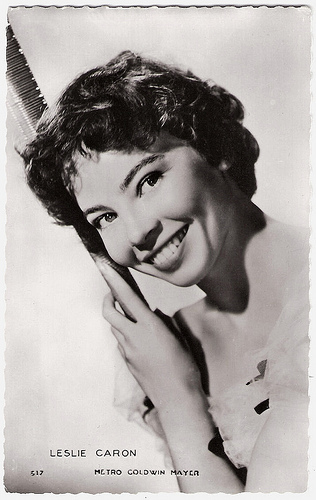
French postcard by Editions P.I., no. 517. Photo: Metro-Goldwyn-Mayer (MGM).
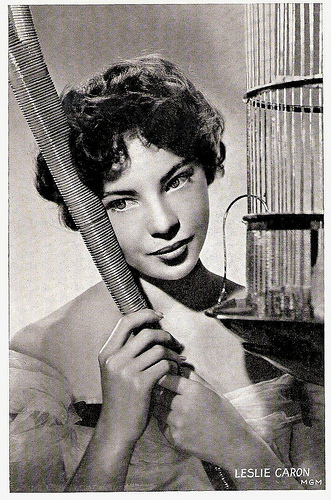
Vintage postcard. Photo: MGM.
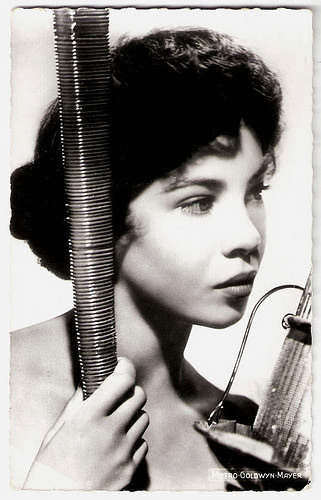
French postcard by Editions du Globe, no. 595. Photo: Metro-Goldwyn-Mayer.
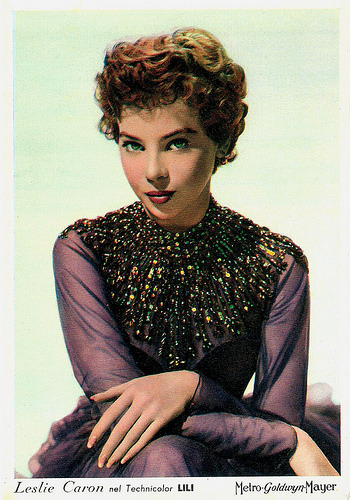
Italian postcard by Zincografica, Firenze. Photo: Metro-Goldwyn-Mayer. Publicity still for Lili (Charles Walters, 1953).
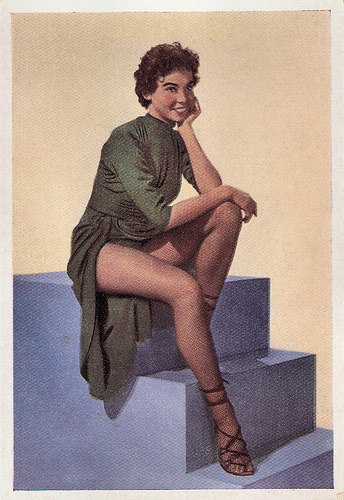
Dutch postcard by Uitgeverij Filmphoto Service, Amsterdam, Serie KF 8. Photo: Metro-Goldwyn-Mayer.
The Ultimate Latin Lover
Leslie Caron projected considerable warmth and charm in such straight dramas as Fanny (Joshua Logan, 1961) opposite Maurice Chevalier , Charles Boyer and Horst Buchholz , and Father Goose (Ralph Nelson, 1964) with Cary Grant.
In 1963 she received a BAFTA and a Golden Globe for the British drama The L-Shaped Room (Bryan Forbes, 1962). In this lovingly observed small-scale drama, she was excellent as an unmarried expectant mother awaiting an abortion who gathers strength from her odd roommates.
In the late 1960s and 1970s, her Hollywood star faded somewhat, and she worked in such European films as the Italian comedy Il padre di famiglia/The Head of the Family (Nanni Loy, 1967) starring Nino Manfredi, the French comedy L’homme qui aimait les femmes/The Man Who Loved Women (Francois Truffaut, 1977), Guerriers et Captives/Warriors and Prisoners (Edgardo Cozinsky, 1989) with Dominique Sanda , and Damage (Louis Malle, 1992) as Juliette Binoche's mother.
In the biopic Valentino (Ken Russell, 1977) she played silent-screen legend Alla Nazimova opposite Rudolf Nureyev as the ultimate Latin lover.
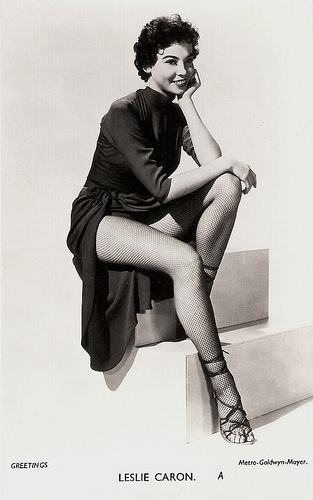
British Greetings postcard, no. A. Photo: Metro-Goldwyn-Mayer (MGM).
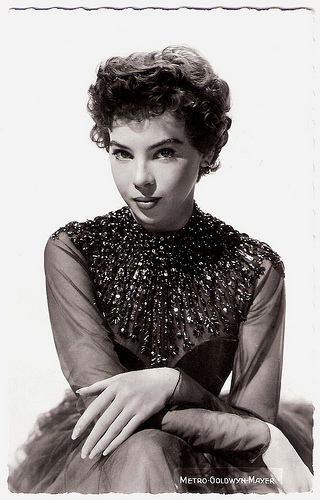
French postcard by Editions du Globe, no. 584. Photo: International Press/Metro-Goldwyn-Mayer (MGM). Publicity still for Lili (Charles Walters, 1953).
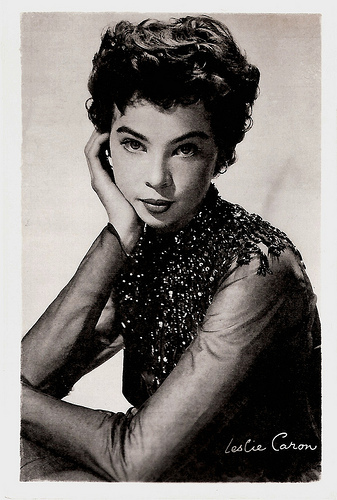
Small vintage card. Publicity still for Lili (Charles Walters, 1953).

French postcard by Editions du Globe, Paris, no. 662. Photo: Sam Lévin. Publicity still for Gigi (Vincente Minelli, 1958).
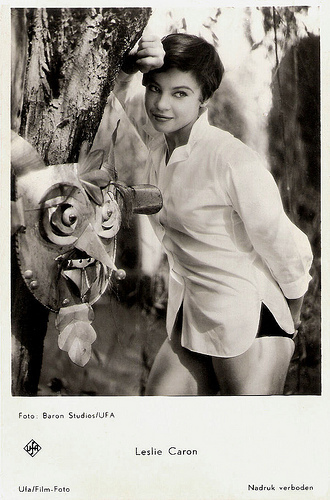
Belgian postcard by D.R.C. Holland, no. 3286. Licency holder for Ufa. Photo: Baron Studios / Ufa.
Emmy Award
Leslie Caron is one of the few stars from the classic era of MGM musicals who is still active in film. Among her more recent films were Chocolat (Lasse Hallström, 2000) with Juliette Binoche, and Le Divorce (2003), director James Ivory's final co-production with longtime partner Ismail Merchant, as Naomi Watts' aristocratic mother, a grande dame who remains steely and imperious in the face of her daughter's mounting tragedies.
In 2007, her guest role as a long-silenced rape victim in the TV series Law and Order: Special Victims Unit earned her a Primetime Emmy Award. In 2010, she played Madame Armfeldt in A Little Night Music at the Théâtre du Châtelet in Paris, with Greta Scacchi and Lambert Wilson.
Caron was married three times. In 1951 she married the American George Hormel II, a grandson of the founder of the famous Spam meat-packing company. It was a foolish starter's marriage and they divorced in 1954. Her second husband was British theatre director Peter Hall. They met in 1956 when he directed her in the stage version of Gigi. They married the same year and had two children, TV producer Christopher John Hall (1957) and former actress and PR agent Jennifer Caron Hall (1962).
In 1963, Caron had an affair with Warren Beatty. When she and Hall divorced in 1965, Beatty was named as a co-respondent and was ordered by the London court to pay the costs of the trial. In 1969, Caron married Michael Laughlin, best known as producer of the road movie Two-Lane Blacktop (Monte Hellman, 1971). They divorced in 1980. Caron was also romantically linked to Dutch television actor Robert Wolders from 1994 to 1995.
Her current partner is (assistant) director Paul C. Magwood, who had directed her in the crime film Chandler (Paul Magwood, 1971) starring Warren Oates. In semi-retirement from films, Leslie Caron owned and operated a bed and breakfast in Villeneuve-sur-Yonne, till 2010. The late French president François Mitterrand personally presented her with the Légion d'Honneur.
In her candid memoir Thank Heaven... (2010) she writes with verve and style about her husbands and lovers, her inspiring directors and celebrity friends, the insider life of the studio star system, triumphs on screen and stage, depression and recovery. She also states that she became an American citizen, like her mother, in time to vote for Barack Obama for President. Her most recent screen appearance was a guest starring role in the popular French TV series Jo (2013) with Jean Reno. Leslie Caron lives on the left bank of Paris.
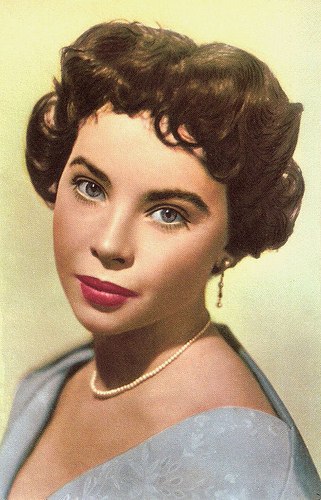
Vintage card.
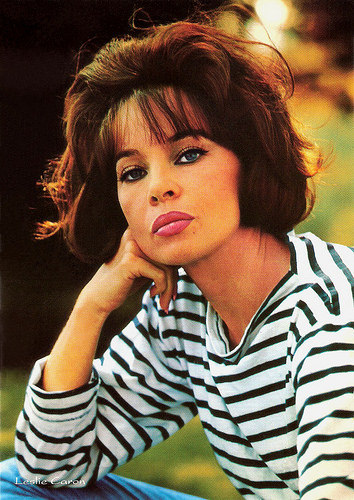
Italian postcard in the Artisti di Sempre series by Ed. ris. Rotalfoto S.p.A., Milano, no. 343.
Trailer for An American in Paris (1951). Source: Warner Bros. Worldwide (YouTube).
Trailer for Lili (1953). Source: Video Detective (YouTube).
Trailer for Gigi (1958). Source: Movieclips Trailer Vault (YouTube).
Sources: Hal Erickson (AllMovie), (IMDb), Jean Bond Rafferty (France Today), Louette Harding (Daily Mail), TCM, NNDB, Wikipedia, and .

German postcard by Krüger, no. 902/34. Photo: Sam Lévin. Photo: publicity still for Gigi (Vincente Minnelli, 1958).

German postcard by Krüger, no. 902/35. Photo: Sam Lévin. Photo: publicity still for Gigi (Vincente Minnelli, 1958).

German postcard by ISV, Amsterdam, no. B 17. Photo: publicity still for Gigi (Vincente Minnelli, 1958).
Overnight Sensation
Leslie Claire Margaret Caron was born in the Paris suburb Boulogne-sur-Seine, (now Boulogne-Billancourt), France, in 1931. She was the daughter of Claude Caron, a French chemist, and Margaret Caron-Petit.
Her mother was an American dancer who briefly made it to Broadway. She had given up her career for marriage, and eventually took her own life. Her father's family was well-to-do, and in her memoir Thank Heaven... (2010), Caron describes her childhood as idyllic, divided between a townhouse in the chic Paris suburb of Neuilly-sur-Seine—with butler, chef, governess, chauffeur and maids—and a country estate in the Pyrenees.
Her mother introduced Leslie to ballet at the age of 10. The Nazi occupation of France forced her to flee to Cannes, but she returned after the war, and by the age of 16, she started her career as a ballet dancer at Roland Petit's Ballet des Champs-Élyées, a new company that was the toast of Paris.
In 1948, she became an overnight sensation as a stunning Sphinx in La Rencontre (The Encounter), David Lichine's experimental and acrobatic ballet about Oedipus and the Sphinx.
Gene Kelly saw her performance, and two years later he cast her to appear opposite him as a ballerina ingénue in An American in Paris (Vincente Minnelli, 1951). The role initially was to be danced by Cyd Charisse, but she was pregnant. So Leslie Caron could dance her way into millions of hearts of filmgoers. Her magical performance and elfin charm led to a long-term MGM contract and a string of memorable films.

Vintage autograph card. Photo: publicity still for An American in Paris (Vincente Minnelli, 1951) with Gene Kelly.

With Maria Tallchief and Moira Shearer. Vintage card no. 535. Photo: Metro-Goldwyn-Mayer.

Dutch postcard by DRC, no. F 109. Photo: MGM.

Dutch postcard by Filmphoto Service, Amsterdam, no. 628. Photo: M.G.M.

British postcard in the Picturegoer Series, London, no. D 363. Photo: Metro-Goldwyn-Mayer.
A French Lady in Hollywood
Hollywood made excellent use of Leslie Caron's ballet training and endearingly girlish screen persona. She proved a perfect partner for Fred Astaire in 20th Century-Fox's Daddy Long Legs (Jean Negulesco, 1955), and an ideal Cinderella in The Glass Slipper (Charles Walters, 1955).
Her greatest hits were the musicals Lili (Charles Walters, 1953) as a naive country girl who falls for a self-pitying puppeteer (Mel Ferrer), and Gigi (Vincente Minnelli, 1958) in which she enchantingly incarnated Colette's heroine, a young girl trained by her aunt (Isabel Jeans) and grandmother (Hermione Gingold) to become the mistress of wealthy young Gaston ( Louis Jourdan ).
Filmed on location in Paris, Gigi won several Oscars, including Best Picture. For Lili, Caron earned her first Academy Award nomination and as well a BAFTA (the British Academy award) nomination.
Both films remain enduring classics decades after their release. They helped to cement Caron's status as one of the select performers who came to fame as part of the Hollywood musical's heydays.
At the end of the 1950s, the heydays of the MGM musicals were over though, and Caron found screen musicals physically taxing. So she had begun to study acting, and Gigi would be her last musical.

French postcard by Editions P.I., no. 517. Photo: Metro-Goldwyn-Mayer (MGM).

Vintage postcard. Photo: MGM.

French postcard by Editions du Globe, no. 595. Photo: Metro-Goldwyn-Mayer.

Italian postcard by Zincografica, Firenze. Photo: Metro-Goldwyn-Mayer. Publicity still for Lili (Charles Walters, 1953).

Dutch postcard by Uitgeverij Filmphoto Service, Amsterdam, Serie KF 8. Photo: Metro-Goldwyn-Mayer.
The Ultimate Latin Lover
Leslie Caron projected considerable warmth and charm in such straight dramas as Fanny (Joshua Logan, 1961) opposite Maurice Chevalier , Charles Boyer and Horst Buchholz , and Father Goose (Ralph Nelson, 1964) with Cary Grant.
In 1963 she received a BAFTA and a Golden Globe for the British drama The L-Shaped Room (Bryan Forbes, 1962). In this lovingly observed small-scale drama, she was excellent as an unmarried expectant mother awaiting an abortion who gathers strength from her odd roommates.
In the late 1960s and 1970s, her Hollywood star faded somewhat, and she worked in such European films as the Italian comedy Il padre di famiglia/The Head of the Family (Nanni Loy, 1967) starring Nino Manfredi, the French comedy L’homme qui aimait les femmes/The Man Who Loved Women (Francois Truffaut, 1977), Guerriers et Captives/Warriors and Prisoners (Edgardo Cozinsky, 1989) with Dominique Sanda , and Damage (Louis Malle, 1992) as Juliette Binoche's mother.
In the biopic Valentino (Ken Russell, 1977) she played silent-screen legend Alla Nazimova opposite Rudolf Nureyev as the ultimate Latin lover.

British Greetings postcard, no. A. Photo: Metro-Goldwyn-Mayer (MGM).

French postcard by Editions du Globe, no. 584. Photo: International Press/Metro-Goldwyn-Mayer (MGM). Publicity still for Lili (Charles Walters, 1953).

Small vintage card. Publicity still for Lili (Charles Walters, 1953).

French postcard by Editions du Globe, Paris, no. 662. Photo: Sam Lévin. Publicity still for Gigi (Vincente Minelli, 1958).

Belgian postcard by D.R.C. Holland, no. 3286. Licency holder for Ufa. Photo: Baron Studios / Ufa.
Emmy Award
Leslie Caron is one of the few stars from the classic era of MGM musicals who is still active in film. Among her more recent films were Chocolat (Lasse Hallström, 2000) with Juliette Binoche, and Le Divorce (2003), director James Ivory's final co-production with longtime partner Ismail Merchant, as Naomi Watts' aristocratic mother, a grande dame who remains steely and imperious in the face of her daughter's mounting tragedies.
In 2007, her guest role as a long-silenced rape victim in the TV series Law and Order: Special Victims Unit earned her a Primetime Emmy Award. In 2010, she played Madame Armfeldt in A Little Night Music at the Théâtre du Châtelet in Paris, with Greta Scacchi and Lambert Wilson.
Caron was married three times. In 1951 she married the American George Hormel II, a grandson of the founder of the famous Spam meat-packing company. It was a foolish starter's marriage and they divorced in 1954. Her second husband was British theatre director Peter Hall. They met in 1956 when he directed her in the stage version of Gigi. They married the same year and had two children, TV producer Christopher John Hall (1957) and former actress and PR agent Jennifer Caron Hall (1962).
In 1963, Caron had an affair with Warren Beatty. When she and Hall divorced in 1965, Beatty was named as a co-respondent and was ordered by the London court to pay the costs of the trial. In 1969, Caron married Michael Laughlin, best known as producer of the road movie Two-Lane Blacktop (Monte Hellman, 1971). They divorced in 1980. Caron was also romantically linked to Dutch television actor Robert Wolders from 1994 to 1995.
Her current partner is (assistant) director Paul C. Magwood, who had directed her in the crime film Chandler (Paul Magwood, 1971) starring Warren Oates. In semi-retirement from films, Leslie Caron owned and operated a bed and breakfast in Villeneuve-sur-Yonne, till 2010. The late French president François Mitterrand personally presented her with the Légion d'Honneur.
In her candid memoir Thank Heaven... (2010) she writes with verve and style about her husbands and lovers, her inspiring directors and celebrity friends, the insider life of the studio star system, triumphs on screen and stage, depression and recovery. She also states that she became an American citizen, like her mother, in time to vote for Barack Obama for President. Her most recent screen appearance was a guest starring role in the popular French TV series Jo (2013) with Jean Reno. Leslie Caron lives on the left bank of Paris.

Vintage card.

Italian postcard in the Artisti di Sempre series by Ed. ris. Rotalfoto S.p.A., Milano, no. 343.
Trailer for An American in Paris (1951). Source: Warner Bros. Worldwide (YouTube).
Trailer for Lili (1953). Source: Video Detective (YouTube).
Trailer for Gigi (1958). Source: Movieclips Trailer Vault (YouTube).
Sources: Hal Erickson (AllMovie), (IMDb), Jean Bond Rafferty (France Today), Louette Harding (Daily Mail), TCM, NNDB, Wikipedia, and .
Published on April 30, 2016 22:00
April 29, 2016
Nelly Corradi
Beautiful Nelly Corradi (1914–1968) was an Italian opera singer and actress.She made her film debut in Max Ophüls’s La signora di tutti (1934) and had her biggest successes after the war with opera films like Lucia di Lammermoor (1946).
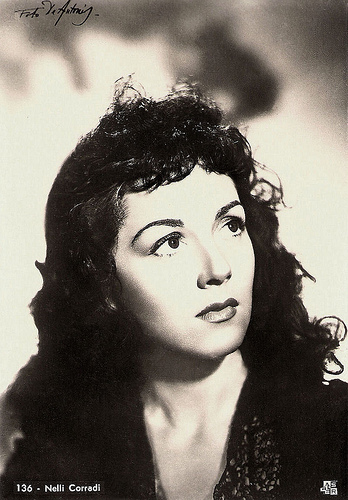
Italian postcard by ASER, no. 137. Photo: De Antonis.
Everybody's Woman
Nelly or Nelli Corradi was born in Parma, Italy, in 1914.
She studied to become a lyrical soprano at the the Conservatory of Parma. After graduating, she started to perform in operas.
In 1934 famous director Max Ophüls spotted her for the cinema and she made her film debut with a supporting part in his La signora di tutti/Everybody's Woman (Max Ophüls, 1934) starring Isa Miranda . It is the only film Max Ophüls made in Italy. The film was a success and made Isa Miranda a star.
Soon followed also leading parts for Corradi in such films as the drama Luci sommerse/Dimmed Lights (Adelqui Migliar, 1934) with Fosco Giacchetti , and Il torrente/The creek (Marco Elter, 1938) with Camillo Pilotto .
She married director Marco Elter and also appeared in his Shakespeare adaptation Dente per dente/Measure for Measure (1943). Elter died in 1945.
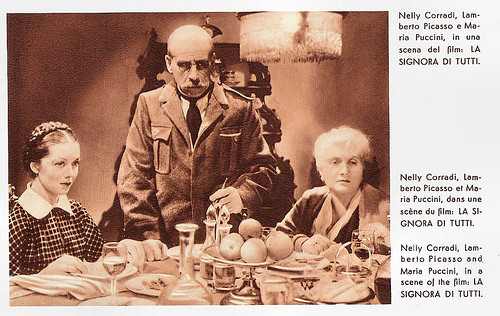
Italian postcard by Rizzoli, Milano, no. 1934-XII. Photo: Novella-Film. Publicity still for La signora di tutti/Everybody's Woman (Max Ophüls, 1934) with Nelly Corradi, Lamberto Picasso and Maria Puccini. Caption: Film prescelta per la II Biennale Cinematograficia di Venezia. (Film selected for the second Venice Film Festival).

Italian postcard by Rizzoli, Milano, no. 1934-XII. Photo: Novella-Film. Publicity still for La signora di tutti/Everybody's Woman (Max Ophüls, 1934) with Enrico Benfer and Nelly Corradi.
Lucia di Lammermoor
Nelly Corradi is probably best known for her post-war starring parts in opera films like Lucia di Lammermoor (Piero Ballerini, 1946).
Fisher L Forrest at IMDb : “This is a very cinematic rendition of the Donizetti favorite featuring beautiful people, beautifully photographed, in beautiful settings. One may cavil that the atmosphere seems more Italian than Scottish, despite a few jaunty feathers in a bonnet or two and Normanno sporting a kilt and tartan plaid. But, what the heck! It is after all an Italian opera. Nelly Corradi is likely the most beautiful Lucia one is likely ever to see on screen or stage. Moreover, she is a consummate actress.”
The success of the film soon lead to other opera films like L'elisir d'amore/Elixir of Love (Mario Costa, 1947), Il barbiere di Siviglia/Barber of Seville (Mario Costa, 1947) with Tito Schippa, La signora dalle camelie/The Lost One (Carmine Gallone, 1947) and La forza del destino/The Force of Destiny (Carmine Gallone, 1950).
She portrayed Margherita (Gretchen) in La leggenda di Faust/Faust (Carmine Gallone, 1950) and played an opera singer in Puccini (Carmine Gallone, 1953), featuring Gabriele Ferzetti . Her final film was Gli orizzonti del sole/The horizons of the sun (Giovanni Paolucci, 1955).
Nelly Corradi died in 1968 in Rome, Italy.
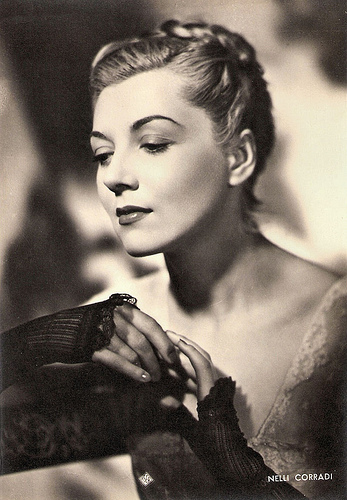
Italian postcard by ASER, no. 173. Photo: De Antonis.
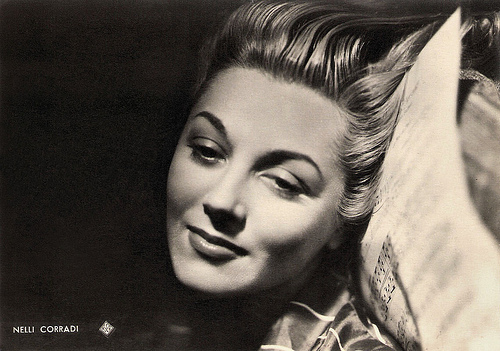
Italian postcard by ASER, no. 170. Photo: De Antonis.
Sources: Wikipedia and .

Italian postcard by ASER, no. 137. Photo: De Antonis.
Everybody's Woman
Nelly or Nelli Corradi was born in Parma, Italy, in 1914.
She studied to become a lyrical soprano at the the Conservatory of Parma. After graduating, she started to perform in operas.
In 1934 famous director Max Ophüls spotted her for the cinema and she made her film debut with a supporting part in his La signora di tutti/Everybody's Woman (Max Ophüls, 1934) starring Isa Miranda . It is the only film Max Ophüls made in Italy. The film was a success and made Isa Miranda a star.
Soon followed also leading parts for Corradi in such films as the drama Luci sommerse/Dimmed Lights (Adelqui Migliar, 1934) with Fosco Giacchetti , and Il torrente/The creek (Marco Elter, 1938) with Camillo Pilotto .
She married director Marco Elter and also appeared in his Shakespeare adaptation Dente per dente/Measure for Measure (1943). Elter died in 1945.

Italian postcard by Rizzoli, Milano, no. 1934-XII. Photo: Novella-Film. Publicity still for La signora di tutti/Everybody's Woman (Max Ophüls, 1934) with Nelly Corradi, Lamberto Picasso and Maria Puccini. Caption: Film prescelta per la II Biennale Cinematograficia di Venezia. (Film selected for the second Venice Film Festival).

Italian postcard by Rizzoli, Milano, no. 1934-XII. Photo: Novella-Film. Publicity still for La signora di tutti/Everybody's Woman (Max Ophüls, 1934) with Enrico Benfer and Nelly Corradi.
Lucia di Lammermoor
Nelly Corradi is probably best known for her post-war starring parts in opera films like Lucia di Lammermoor (Piero Ballerini, 1946).
Fisher L Forrest at IMDb : “This is a very cinematic rendition of the Donizetti favorite featuring beautiful people, beautifully photographed, in beautiful settings. One may cavil that the atmosphere seems more Italian than Scottish, despite a few jaunty feathers in a bonnet or two and Normanno sporting a kilt and tartan plaid. But, what the heck! It is after all an Italian opera. Nelly Corradi is likely the most beautiful Lucia one is likely ever to see on screen or stage. Moreover, she is a consummate actress.”
The success of the film soon lead to other opera films like L'elisir d'amore/Elixir of Love (Mario Costa, 1947), Il barbiere di Siviglia/Barber of Seville (Mario Costa, 1947) with Tito Schippa, La signora dalle camelie/The Lost One (Carmine Gallone, 1947) and La forza del destino/The Force of Destiny (Carmine Gallone, 1950).
She portrayed Margherita (Gretchen) in La leggenda di Faust/Faust (Carmine Gallone, 1950) and played an opera singer in Puccini (Carmine Gallone, 1953), featuring Gabriele Ferzetti . Her final film was Gli orizzonti del sole/The horizons of the sun (Giovanni Paolucci, 1955).
Nelly Corradi died in 1968 in Rome, Italy.

Italian postcard by ASER, no. 173. Photo: De Antonis.

Italian postcard by ASER, no. 170. Photo: De Antonis.
Sources: Wikipedia and .
Published on April 29, 2016 22:00
April 28, 2016
EFSP's Dazzling Dozen: Stars on Vespas
In the bathroom of our home hangs a hilarious picture of Charlton Heston and Stephen Boyd in their Ben Hur outfits. On their sandals, they are pushing a Vespa scooter through the sand of the arena. The Vespa has evolved from a single model motor scooter manufactured in 1946 by Piaggio & Co. S.p.A. of Pontedera, Italy to a full line of scooters and one of seven companies today owned by Piaggio. The picture of Heston and Boyd was made for an advertisement series by Piaggio in the late 1950s. We found a series of postcards with several other stars on Vespas. For this post we chose our twelve favourites. Andiamo! Vroom, vroom.
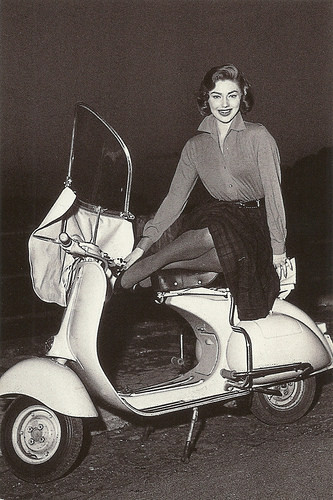
Sylva Koscina . Italian postcard by Ed Graphicarta, Pontedera in the Kit Postcards Vespa series of Piaggio.
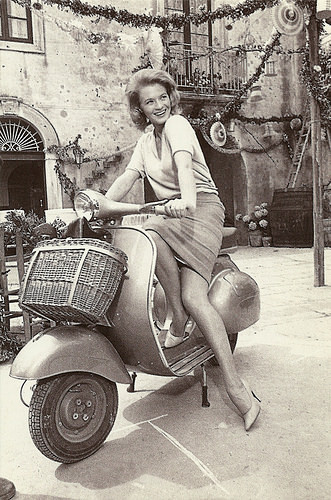
Angie Dickinson. Italian postcard by Ed Graphicarta, Pontedera in the Kit Postcards Vespa series of Piaggio. Dickinson was in Italy for at least two films: Jessica (Jean Negulesco, Oreste Palella, 1962), shot in Sicily but also at the Roman DEAR studios, and Rome Adventure (Delmer Daves 1962), starring Suzanne Pleshette and Troy Donahue.
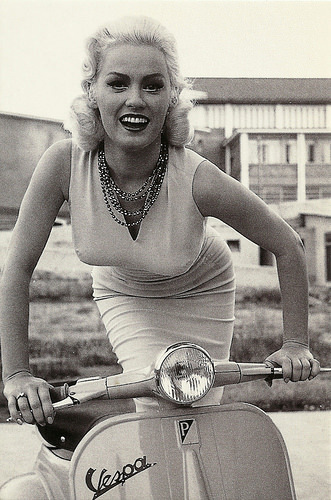
Mamie van Doren . Italian postcard by Ed Graphicarta, Pontedera in the Kit Postcards Vespa series of Piaggio. In 1958 Van Doren acted in Rome in Le bellissime gambe di Sabrina/The Beautiful Legs of Sabrina (Camillo Mastrocinque, 1958).
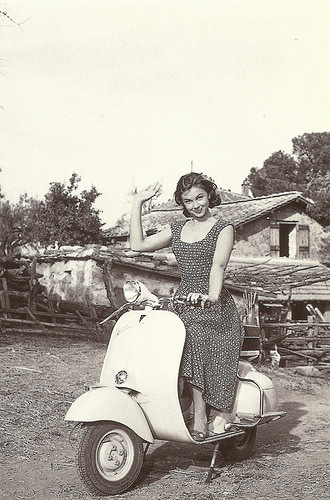
Lorella De Luca . Italian postcard by Ed Graphicarta, Pontedera in the Kit Postcards Vespa series of Piaggio. Lorella De Luca had her debut in Il bidone (Federico Fellini, 1955) and from then on had a steady career in films like Poveri ma belli (Dino Risi, 1957) and Padri e figli (Mario Monicelli, 1957).
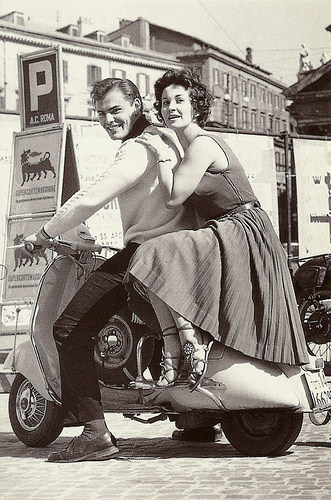
John Saxon and Luisa Rivelli . Italian postcard by Ed Graphicarta, Pontedera in the Kit Postcards Vespa series of Piaggio.
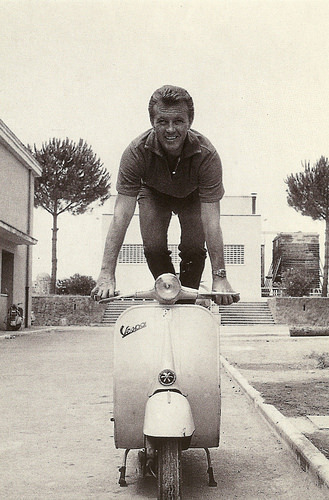
Jacques Sernas at the premises of Cinecittà. Italian postcard by Ed Graphicarta, Pontedera in the Kit Postcards Vespa series of Piaggio. Sernas already debuted in Italian cinema in 1948 and acted in countless Italian films, of which La dolce vita (Federico Fellini, 1960) is the most famous one.
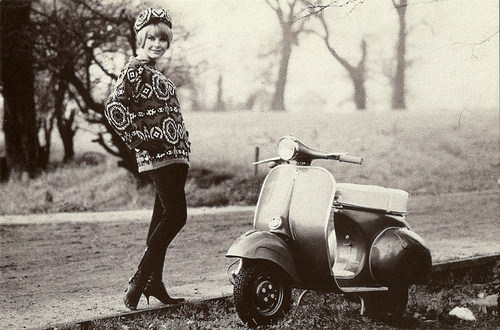
Elke Sommer. Italian postcard by Ed Graphicarta, Pontedera in the Kit Postcards Vespa series of Piaggio. German actress Elke Sommer did various films in Italy in 1959-1960. She returned occassionally, e.g. for Luigi Comencini's episode in Le bambole (1965).
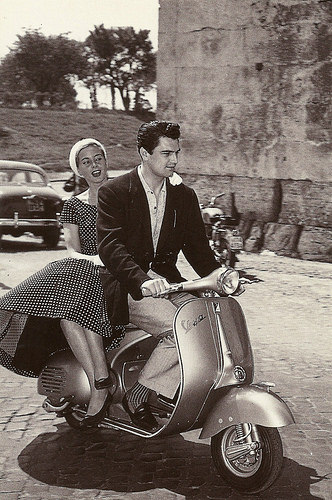
Edmund Purdom and Genevieve Page . Italian postcard by Ed Graphicarta, Pontedera in the Kit Postcards Vespa series of Piaggio. In 1957 the couple acted in Rome in Agguato a Tangeri/Trapped in Tangiers by Riccardo Freda and Jorge Grau.
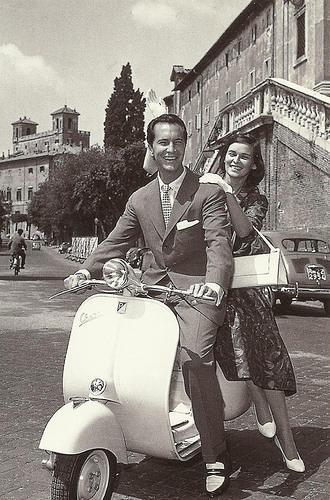
Luis Dominguin and Lucia Bosè . Italian postcard by Ed Graphicarta, Pontedera in the Kit Postcards Vespa series of Piaggio. The photo is taken at Trinità dei Monti, in the back Villa Medici, Rome.
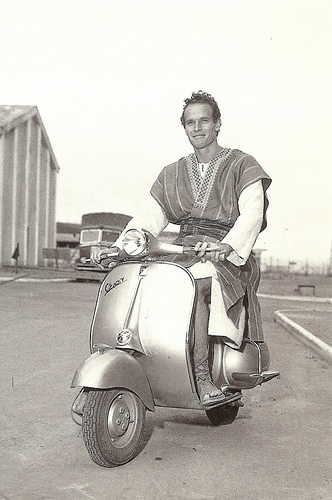
Charlton Heston. Italian postcard by Ed Graphicarta, Pontedera in the Kit Postcards Vespa series of Piaggio. Heston at the Cinecittà backlot during the shooting of Ben-Hur (Wiliam Wyler, 1959).
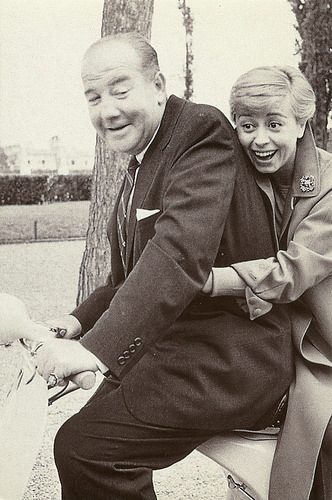
Broderick Crawford and Giulietta Masina . Italian postcard by Ed Graphicarta, Pontedera in the Kit Postcards Vespa series of Piaggio. The couple played together in Federico Fellini's Il bidone (1955).
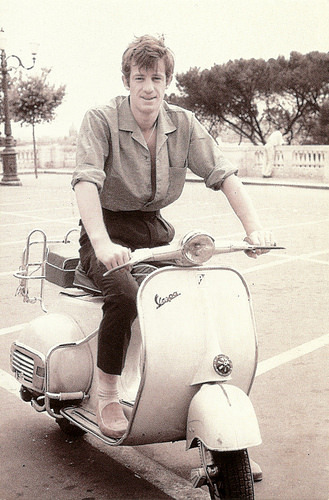
Jean-Paul Belmondo . Italian postcard by Ed Graphicarta, Pontedera in the Kit Postcards Vespa series of Piaggio. In 1960-1962 Belmondo acted in various films shot in and around Rome: Lettere di una novizia (Alberto Lattuada, 1960), La ciociara (Vittorio De Sica, 1960), La viaccia (Mauro Bolognini, 1961). In 1963 he returned for a few bit parts and a lead in Mare matto (Renato Castellani, 1963).
This is a post for Postcard Friendship Friday, hosted by Beth at the The Best Hearts are Crunchy. You can visit her by clicking on the button below.


Sylva Koscina . Italian postcard by Ed Graphicarta, Pontedera in the Kit Postcards Vespa series of Piaggio.

Angie Dickinson. Italian postcard by Ed Graphicarta, Pontedera in the Kit Postcards Vespa series of Piaggio. Dickinson was in Italy for at least two films: Jessica (Jean Negulesco, Oreste Palella, 1962), shot in Sicily but also at the Roman DEAR studios, and Rome Adventure (Delmer Daves 1962), starring Suzanne Pleshette and Troy Donahue.

Mamie van Doren . Italian postcard by Ed Graphicarta, Pontedera in the Kit Postcards Vespa series of Piaggio. In 1958 Van Doren acted in Rome in Le bellissime gambe di Sabrina/The Beautiful Legs of Sabrina (Camillo Mastrocinque, 1958).

Lorella De Luca . Italian postcard by Ed Graphicarta, Pontedera in the Kit Postcards Vespa series of Piaggio. Lorella De Luca had her debut in Il bidone (Federico Fellini, 1955) and from then on had a steady career in films like Poveri ma belli (Dino Risi, 1957) and Padri e figli (Mario Monicelli, 1957).

John Saxon and Luisa Rivelli . Italian postcard by Ed Graphicarta, Pontedera in the Kit Postcards Vespa series of Piaggio.

Jacques Sernas at the premises of Cinecittà. Italian postcard by Ed Graphicarta, Pontedera in the Kit Postcards Vespa series of Piaggio. Sernas already debuted in Italian cinema in 1948 and acted in countless Italian films, of which La dolce vita (Federico Fellini, 1960) is the most famous one.

Elke Sommer. Italian postcard by Ed Graphicarta, Pontedera in the Kit Postcards Vespa series of Piaggio. German actress Elke Sommer did various films in Italy in 1959-1960. She returned occassionally, e.g. for Luigi Comencini's episode in Le bambole (1965).

Edmund Purdom and Genevieve Page . Italian postcard by Ed Graphicarta, Pontedera in the Kit Postcards Vespa series of Piaggio. In 1957 the couple acted in Rome in Agguato a Tangeri/Trapped in Tangiers by Riccardo Freda and Jorge Grau.

Luis Dominguin and Lucia Bosè . Italian postcard by Ed Graphicarta, Pontedera in the Kit Postcards Vespa series of Piaggio. The photo is taken at Trinità dei Monti, in the back Villa Medici, Rome.

Charlton Heston. Italian postcard by Ed Graphicarta, Pontedera in the Kit Postcards Vespa series of Piaggio. Heston at the Cinecittà backlot during the shooting of Ben-Hur (Wiliam Wyler, 1959).

Broderick Crawford and Giulietta Masina . Italian postcard by Ed Graphicarta, Pontedera in the Kit Postcards Vespa series of Piaggio. The couple played together in Federico Fellini's Il bidone (1955).

Jean-Paul Belmondo . Italian postcard by Ed Graphicarta, Pontedera in the Kit Postcards Vespa series of Piaggio. In 1960-1962 Belmondo acted in various films shot in and around Rome: Lettere di una novizia (Alberto Lattuada, 1960), La ciociara (Vittorio De Sica, 1960), La viaccia (Mauro Bolognini, 1961). In 1963 he returned for a few bit parts and a lead in Mare matto (Renato Castellani, 1963).
This is a post for Postcard Friendship Friday, hosted by Beth at the The Best Hearts are Crunchy. You can visit her by clicking on the button below.

Published on April 28, 2016 22:00
April 27, 2016
Cathia Caro
Former French actress Cathia Caro (1943) was a young, delicate beauty. At the turn of the 1950s and 1960s, she starred in French and especially Italian films, opposite such stars as Totò, Peppino De Filippo and Aldo Fabrizi.
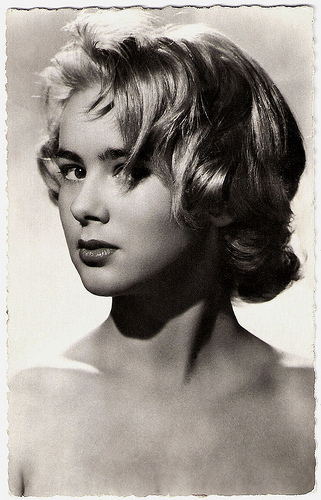
French postcard by Editions du Globe, Paris, no. 735. Photo: Lucienne Chevert.
Isabelle Is Afraid of Men
Cathia Caro was born in Rouen, France, in 1943. Caro first appeared on the big screen in the title role of the film Isabelle a peur des homes/Isabelle Is Afraid of Men (Jean Gourguet, 1957). At the time she was only 14 years old.
She then played the daughter of Arletty and the girlfriend of Jean-Paul Belmondo in the comedy Un drôle de dimanche/What a Sunday (Marc Allégret, 1958). Mario Gauci at IMDb : “A pleasant enough effort, then, if strictly minor (and, ultimately, pretty forgettable) fare.”
In the following years she was particularly active in Italy. She played in well known films such as the comedy Arrangiatevi!/You're on Your Own (Mauro Bolognini, 1959) with Peppino De Filippo , Estate violent/Violent Summer (Valerio Zurlini, 1959) with Eleonora Rossi Drago , and especially the entertaining satire Tartassati/The Over-taxed (Steno, 1959) with Totò and Aldo Fabrizi.
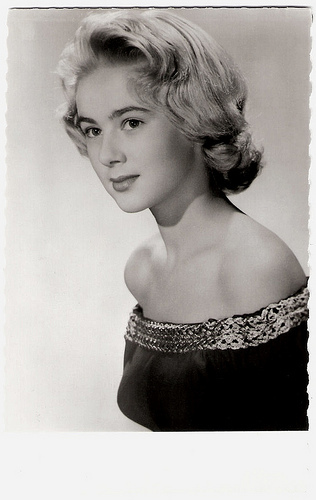
French postcard by Editions P.I, Paris, no. 938, offered by "Les Carbones Korès Çarboplane". Photo: Lucienne Chevert.
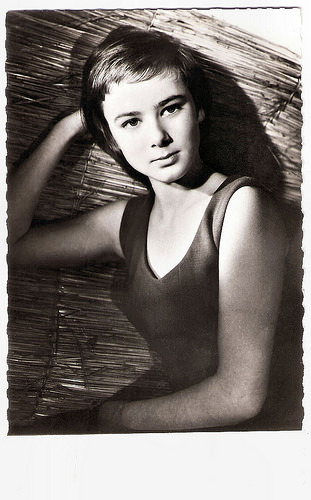
French postcard by Editions P.I, Paris, no. 916, offered by "Les Carbones Korès Çarboplane". Photo: Bernard & Vauclair.
Static and Hokey
In 1959 Cathia Caro made headlines when she attempted suicide. She had a troubled relationship with the boxer Tiberio Mitri.
At the beginning of the 1960s, her career had a boost with the peplum I giganti della Tessaglia/The Giants of Thessaly (Riccardo Freda, 1960). Mario Gauci at IMDb : “Riccardo Freda's involvement here ensures that this is one of the better peplums, even if the result is rather static and hokey overall.”
That year she also co-starred with Peppino De Filippo and Ugo Tognazzi in Genitori in blue-jeans/Parents in blue jeans (Camillo Mastrocinque, 1960).
In the following year she made her final film, the mediocre peplum Il trionfo di Maciste/Triumph of Maciste (Tanio Boccia, 1961) with bodybuilder Kirk Morris. She was only 18 when she retired from the film industry.
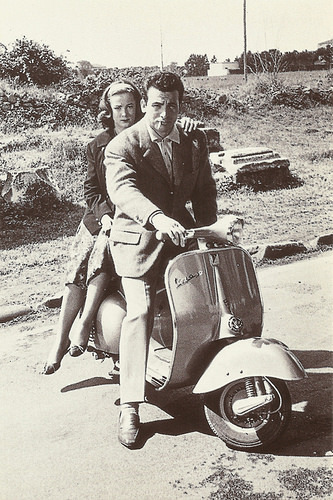
Italian postcard for Piaggio by Ed. Pontedera. Maurizio Arena and Cathia Caro on a scooter, c. 1960. Caro and Rena played together in e.g. Simpatico mascalzone/Likeable rascal (Mario Amendola, 1959), and Il principe fusto/The Stem Prince (1960), directed by Arena himself.
Tomorrow, twelve more postcards with stars on a Vespa in EFSP's Dazzling Dozen.
Sources: Geoffroy Caillet (Les Gens du Cinéma – French), Mario Gauci (IMDb), AllMovie, Wikipedia (Italian and French) and .

French postcard by Editions du Globe, Paris, no. 735. Photo: Lucienne Chevert.
Isabelle Is Afraid of Men
Cathia Caro was born in Rouen, France, in 1943. Caro first appeared on the big screen in the title role of the film Isabelle a peur des homes/Isabelle Is Afraid of Men (Jean Gourguet, 1957). At the time she was only 14 years old.
She then played the daughter of Arletty and the girlfriend of Jean-Paul Belmondo in the comedy Un drôle de dimanche/What a Sunday (Marc Allégret, 1958). Mario Gauci at IMDb : “A pleasant enough effort, then, if strictly minor (and, ultimately, pretty forgettable) fare.”
In the following years she was particularly active in Italy. She played in well known films such as the comedy Arrangiatevi!/You're on Your Own (Mauro Bolognini, 1959) with Peppino De Filippo , Estate violent/Violent Summer (Valerio Zurlini, 1959) with Eleonora Rossi Drago , and especially the entertaining satire Tartassati/The Over-taxed (Steno, 1959) with Totò and Aldo Fabrizi.

French postcard by Editions P.I, Paris, no. 938, offered by "Les Carbones Korès Çarboplane". Photo: Lucienne Chevert.

French postcard by Editions P.I, Paris, no. 916, offered by "Les Carbones Korès Çarboplane". Photo: Bernard & Vauclair.
Static and Hokey
In 1959 Cathia Caro made headlines when she attempted suicide. She had a troubled relationship with the boxer Tiberio Mitri.
At the beginning of the 1960s, her career had a boost with the peplum I giganti della Tessaglia/The Giants of Thessaly (Riccardo Freda, 1960). Mario Gauci at IMDb : “Riccardo Freda's involvement here ensures that this is one of the better peplums, even if the result is rather static and hokey overall.”
That year she also co-starred with Peppino De Filippo and Ugo Tognazzi in Genitori in blue-jeans/Parents in blue jeans (Camillo Mastrocinque, 1960).
In the following year she made her final film, the mediocre peplum Il trionfo di Maciste/Triumph of Maciste (Tanio Boccia, 1961) with bodybuilder Kirk Morris. She was only 18 when she retired from the film industry.

Italian postcard for Piaggio by Ed. Pontedera. Maurizio Arena and Cathia Caro on a scooter, c. 1960. Caro and Rena played together in e.g. Simpatico mascalzone/Likeable rascal (Mario Amendola, 1959), and Il principe fusto/The Stem Prince (1960), directed by Arena himself.
Tomorrow, twelve more postcards with stars on a Vespa in EFSP's Dazzling Dozen.
Sources: Geoffroy Caillet (Les Gens du Cinéma – French), Mario Gauci (IMDb), AllMovie, Wikipedia (Italian and French) and .
Published on April 27, 2016 22:00
April 26, 2016
Elizabeth The Golden Age (2007)
The British-French-German-American coproduction Elizabeth: The Golden Age (Shekhar Kapur, 2007) is the sequel to Elizabeth (Shekhar Kapur, 1998), both produced by Universal Pictures and Working Title Films. Australian actress Cate Blanchett stars as Queen Elizabeth I of England.
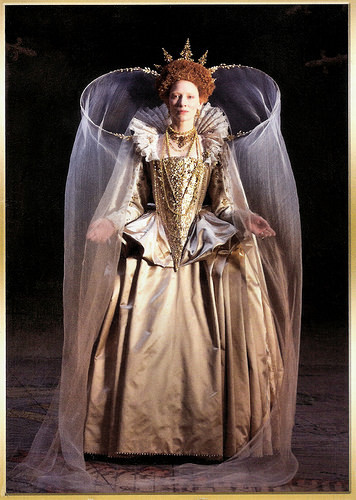
Cate Blanchett. German postcard by Universal Pictures.de for the DVD release. Photo: Universal. Publicity still for Elizabeth: the Golden Age (Shekhar Kapur, 2007).
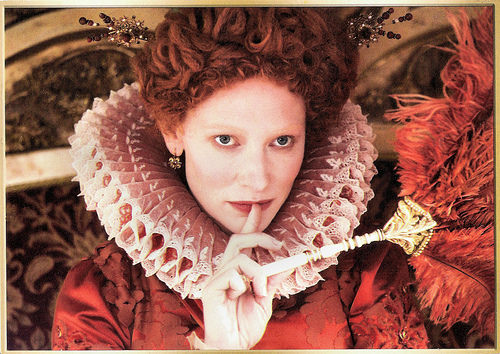
Cate Blanchett. German postcard by Universal Pictures.de for the DVD release. Photo: Universal. Publicity still for Elizabeth: the Golden Age (Shekhar Kapur, 2007).
The Trap for Elisabeth
Elizabeth: The Golden Age is a fairly fictionalised portrayal of events during the latter part of her reign. It's 1595 and Spain is the most powerful empire in the world.
King Philip II of Spain (Jordi Mollà), a devout Catholic, wants to bring down the protestant Elizabeth (Cate Blanchett). He is building an armada but needs a rationale to attack.
With covert intrigue, Spain sets a trap for the Queen and her principal secretary, Walsingham (Geoffrey Rush), using as a pawn Elizabeth's cousin Mary Stuart (Samantha Morton), who's under house arrest in the North.
The trap springs, and the armada sets sail, to rendezvous with French ground forces and to attack. During these months, the Virgin Queen falls in love with Sir Walter Raleigh (Clive Owen), keeping him close to court and away from the sea and America. Is treachery or heroism at his heart?
Elizabeth: The Golden Age premiered at the Toronto International Film Festival in 2007. The film won an Academy Award for Best Costume Design and Blanchett received a nomination for Best Actress, becoming the first female actor to receive another Academy Award nomination for the reprisal of the same role.
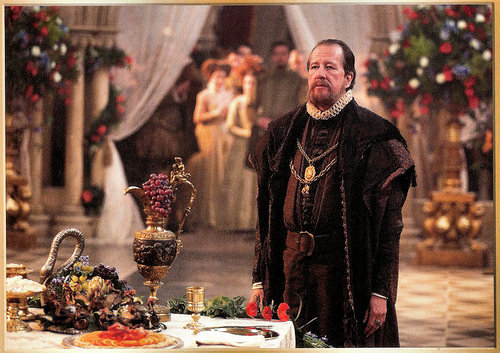
Geoffrey Rush. German postcard by Universal Pictures.de for the DVD release. Photo: Universal. Publicity still for Elizabeth: the Golden Age (Shekhar Kapur, 2007).
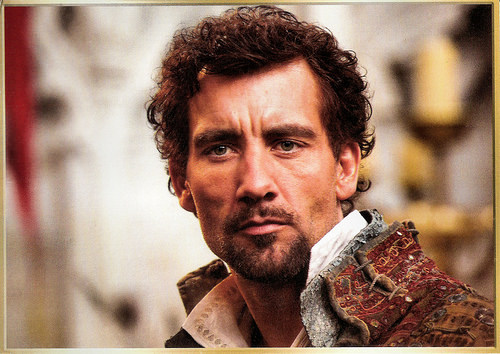
Clive Owen. German postcard by Universal Pictures.de for the DVD release. Photo: Universal. Publicity still for Elizabeth: the Golden Age (Shekhar Kapur, 2007).
Los Angeles' newest cause célèbre
In 1998, Elizabeth (Shekhar Kapur, 1998) had drawn swift and unequivocal praise, and Blanchett's portrayal of the queen had turned her into Los Angeles' newest cause célèbre.
A plethora of awards greeted Kapur's feature and Blanchett's performance, including a Best Actress Academy Award nomination and eight additional Oscar nods. The actress won a Golden Globe and British Academy Award, in addition to a host of critics' circle awards.
However, critics did not like the sequel. Cammila Collar at AllMovie : "As it stands on its own, Elizabeth: The Golden Age is a delightfully bombastic period melodrama, full of sex and war and beautiful dresses. Unfortunately, as a sequel to 1998's Elizabeth (which dealt with earlier events in the 16th century monarch's reign) it's a pale imitator to the throne.
The original Elizabeth grandly showcased the epic nature of a historical turning point, while simultaneously succeeding as both a political thriller and a passionately doomed romance. Add to that themes about God, power, and the manifestations of masculinity and femininity, and you had something so incredible that simply calling it a 'period film' would be like calling The Godfather just another gangster movie. This gave The Golden Age a lot to live up to as a sequel, and unfortunately, it would appear that director Shekhar Kapur just didn't attempt to do so on all fronts."
At IMDb , D. Bruce Brown writes: "It is dazzling and Blanchett can't be denied, but Elizabeth: The Golden Age is like a chick-flick with explosions plus costumes, super hair, and loud, intrusive music. The result is faux epic."
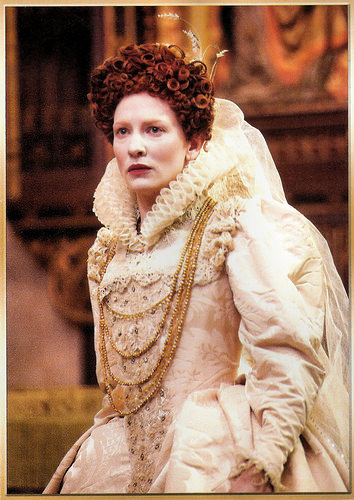
Cate Blanchett. German postcard by Universal Pictures.de for the DVD release. Photo: Universal. Publicity still for Elizabeth: the Golden Age (Shekhar Kapur, 2007).
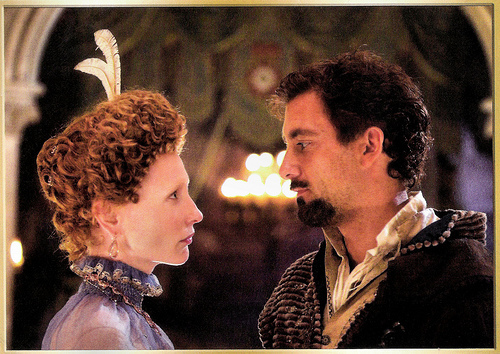
Cate Blanchett and Clive Owen. German postcard by Universal Pictures.de for the DVD release. Photo: Universal. Publicity still for Elizabeth: the Golden Age (Shekhar Kapur, 2007).
Elizabeth: The Golden Age (2007). Official Trailer #1. Source: Movieclips (YouTube).
Sources: Cammila Collar (AllMovie), D. Bruce Brown (IMDb), AllMovie, Wikipedia and IMDb.

Cate Blanchett. German postcard by Universal Pictures.de for the DVD release. Photo: Universal. Publicity still for Elizabeth: the Golden Age (Shekhar Kapur, 2007).

Cate Blanchett. German postcard by Universal Pictures.de for the DVD release. Photo: Universal. Publicity still for Elizabeth: the Golden Age (Shekhar Kapur, 2007).
The Trap for Elisabeth
Elizabeth: The Golden Age is a fairly fictionalised portrayal of events during the latter part of her reign. It's 1595 and Spain is the most powerful empire in the world.
King Philip II of Spain (Jordi Mollà), a devout Catholic, wants to bring down the protestant Elizabeth (Cate Blanchett). He is building an armada but needs a rationale to attack.
With covert intrigue, Spain sets a trap for the Queen and her principal secretary, Walsingham (Geoffrey Rush), using as a pawn Elizabeth's cousin Mary Stuart (Samantha Morton), who's under house arrest in the North.
The trap springs, and the armada sets sail, to rendezvous with French ground forces and to attack. During these months, the Virgin Queen falls in love with Sir Walter Raleigh (Clive Owen), keeping him close to court and away from the sea and America. Is treachery or heroism at his heart?
Elizabeth: The Golden Age premiered at the Toronto International Film Festival in 2007. The film won an Academy Award for Best Costume Design and Blanchett received a nomination for Best Actress, becoming the first female actor to receive another Academy Award nomination for the reprisal of the same role.

Geoffrey Rush. German postcard by Universal Pictures.de for the DVD release. Photo: Universal. Publicity still for Elizabeth: the Golden Age (Shekhar Kapur, 2007).

Clive Owen. German postcard by Universal Pictures.de for the DVD release. Photo: Universal. Publicity still for Elizabeth: the Golden Age (Shekhar Kapur, 2007).
Los Angeles' newest cause célèbre
In 1998, Elizabeth (Shekhar Kapur, 1998) had drawn swift and unequivocal praise, and Blanchett's portrayal of the queen had turned her into Los Angeles' newest cause célèbre.
A plethora of awards greeted Kapur's feature and Blanchett's performance, including a Best Actress Academy Award nomination and eight additional Oscar nods. The actress won a Golden Globe and British Academy Award, in addition to a host of critics' circle awards.
However, critics did not like the sequel. Cammila Collar at AllMovie : "As it stands on its own, Elizabeth: The Golden Age is a delightfully bombastic period melodrama, full of sex and war and beautiful dresses. Unfortunately, as a sequel to 1998's Elizabeth (which dealt with earlier events in the 16th century monarch's reign) it's a pale imitator to the throne.
The original Elizabeth grandly showcased the epic nature of a historical turning point, while simultaneously succeeding as both a political thriller and a passionately doomed romance. Add to that themes about God, power, and the manifestations of masculinity and femininity, and you had something so incredible that simply calling it a 'period film' would be like calling The Godfather just another gangster movie. This gave The Golden Age a lot to live up to as a sequel, and unfortunately, it would appear that director Shekhar Kapur just didn't attempt to do so on all fronts."
At IMDb , D. Bruce Brown writes: "It is dazzling and Blanchett can't be denied, but Elizabeth: The Golden Age is like a chick-flick with explosions plus costumes, super hair, and loud, intrusive music. The result is faux epic."

Cate Blanchett. German postcard by Universal Pictures.de for the DVD release. Photo: Universal. Publicity still for Elizabeth: the Golden Age (Shekhar Kapur, 2007).

Cate Blanchett and Clive Owen. German postcard by Universal Pictures.de for the DVD release. Photo: Universal. Publicity still for Elizabeth: the Golden Age (Shekhar Kapur, 2007).
Elizabeth: The Golden Age (2007). Official Trailer #1. Source: Movieclips (YouTube).
Sources: Cammila Collar (AllMovie), D. Bruce Brown (IMDb), AllMovie, Wikipedia and IMDb.
Published on April 26, 2016 22:00
April 25, 2016
Nicole Berger
Fair-haired Nicole Berger (1934-1967) was a French leading lady of the 1950s and 1960s, who appeared in several Nouvelle Vague films. Her promising career was cut short by a car crash near Rouen.
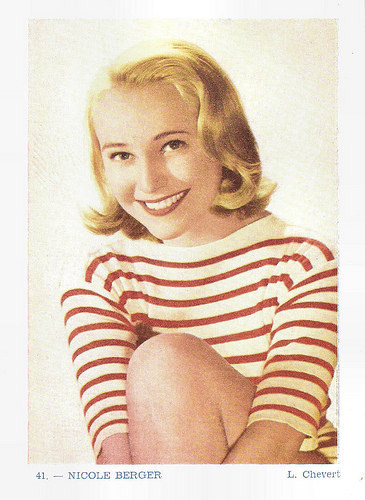
Belgian collectors card by Merbotex, Bruxelles / Palace Izegem, no. 41. Photo: Lucienne Chevert.
Sidewalk café Cokes and Tuileries park benches
Nicole Berger was born Nicole Gouspeyre in Paris in 1934. She had a brief theatrical career, particularly in the Compagnie Barrault-Renaud, before she started to work in the cinema.
She made her film debut in a small part in Jocelyn (Jacques de Casembroot, 1952) as the sister of Jean Desailly and then played a supporting part in the French comedy Julietta (Marc Allégret, 1953|), starring Dany Robin and Jean Marais .
The following year, director Claude Autant-Lara gave her her first real chance. He offered her one of the three leading roles opposite Edwige Feuillère and Pierre-Michel Beck in Le Blé en herbe/The Game of Love (Claude Autant-Lara, 1954), based on the novel by Colette.
She then played in several international films. In Germany she starred in Ein Mädchen aus Flandern/The Girl from Flanders (Helmut Käutner, 1956) and in the Swedish-Argentinean film Livets vår/Spring of Life (Arne Mattsson, 1958) with Folke Sundquist. She also played a supporting part in the French film Celui qui doit mourir/He Who Must Die (Jules Dassin, 1957), starring Jean Servais and Carl Möhner . The film, based on the novel O Hristos Xanastavronetai (Christ Recrucified) by Nikos Kazantzakis, was entered into the 1957 Cannes Film Festival.
She reunited with Claude Autant-Lara for the crime film En cas de malheur/Love Is My Profession (Claude Autant-Lara, 1958), after a novel by Georges Simenon. She played the maid of femme fatale Brigitte Bardot . That year she also starred in Véronique et son cancre/Veronique and Her Dunce (1958), a short comedy film by Éric Rohmer, which he directed before his series of Contes moraux/Six Moral Tales.
She also appeared in the short Tous les garçons s'appellent Patrick/All Boys Are Called Patrick (1959) written by Éric Rohmer and directed by Jean-Luc Godard. Michael Buening at AllMovie : “a slight, but charming, story about two girlfriends (Nicole Berger and Anne Collette) who are seduced by Lothario Patrick ( Jean-Claude Brialy ) over sidewalk café Cokes and on Tuileries park benches. When both Charlotte and Véronique arrive for the date, Patrick brings another woman. The story is told in a fairly straightforward style. Godard's early love of youthful frivolity, pop culture, and referential film geekery are in abundant evidence (the girls' apartment walls are decorated with film posters, they mimic their idols) and there are some tentative steps taken with visual and audio jump cuts.”
In the following years Rohmer and Godard would achieve fame as directors of the Nouvelle Vague, the French New Wave. She also worked with François Truffaut and appeared in his feature film Tirez sur le pianist/Shoot the Piano Player (François Truffaut, 1960) starring Charles Aznavour as a small time piano player in a bar who has a secret past that he keeps hidden.
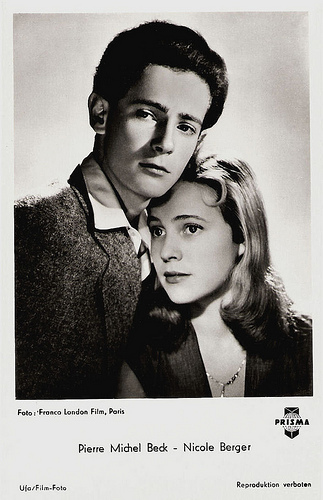
German postcard by Ufa, Berlin-Tempelhof, no. FK 1463. Photo: Franco London Film, Paris / Prisma. Publicity still for Le Blé en herbe/The Game of Love (Claude Autant-Lara, 1954) with Pierre-Michel Beck.
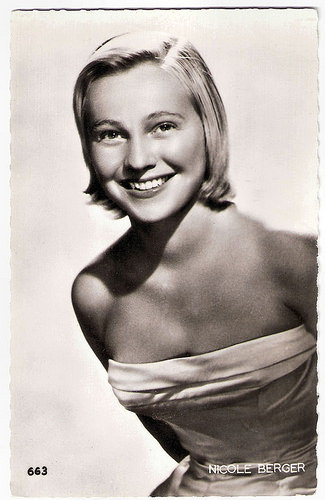
French postcard by Editions P.I., Paris, no. 663. Photo: Lucienne Chevert.
The father of the Blaxploitation
Nicole Berger appeared in the British historical drama The Siege of Sidney Street (Robert S. Baker, Monty Berman, 1960 with Donald Sinden and Kieron Moore . The film depicts the 1911 Siege of Sidney Street in which armed police surrounded a house occupied by a gang in the East End of London.
In France she appeared in the crime dramas La denunciation/The Denunciation (Jacques Doniol-Valcroze, 1962) opposite Maurice Ronet , and Chair de poule/Highway Pickup (Julien Duvivier, 1963) starring Robert Hossein and Catherine Rouvel. The screenplay of the latter is based on the novel Come Easy, Go Easy by James Hadley Chase.
James Travers at Films de France: “Chair de poule is among the most overlooked and underrated of Julien Duvivier's films and yet, whilst clearly not the director's greatest work, it has many commendable features and serves as a highly respectable homage to the American film noir thrillers of the 1950s.”
During the 1960s Nicole Berger turned to television, and played in several TV-films. She was also the protagonist of the popular soap Cécilia, médecin de campagne/Cecilia country doctor (André Michel, 1966).
Her final film was the experimental feature La Permission/The Story of a Three-Day Pass (Melvin Van Peebles, 1967). Wikipedia: "In the early 1960s, young filmmaker Melvin Van Peebles was unable to establish himself as a film director in Hollywood because the concept of a black director was unheard of in America at that time. Consequently, he went to France, learned the language, and wrote La Permission in French. Learning he could adapt one of his novels into film with a $60,000 grant from the French Cinema Center, so long as his film was 'artistically valuable, but not necessarily commercially viable,' he sought a film producer, and shot La Permission in 36 days for a cost of $200,000."
Harry Baird plays a black American GI, Turner, who falls in love with a French girl (Nicole Berger). Upon his return from an idyllic weekend, Turner is demoted by his bigoted captain for fraternising with a white girl. In the following years, Van Peebles became the father of the ‘blaxploitation’ film.
In 1967, Nicole Berger was killed in a car crash not far from the French town of Rouen. She was thrown from a car driven by actress Dany Dauberson. Berger was only 32.
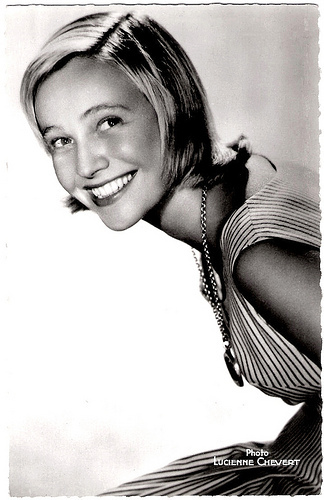
French postcard by Editions du Globe, Paris, no. 424. Photo: Lucienne Chevert.
Sources: Michael Buening (AllMovie), James Travers (Films de France), AllMovie, Wikipedia and .

Belgian collectors card by Merbotex, Bruxelles / Palace Izegem, no. 41. Photo: Lucienne Chevert.
Sidewalk café Cokes and Tuileries park benches
Nicole Berger was born Nicole Gouspeyre in Paris in 1934. She had a brief theatrical career, particularly in the Compagnie Barrault-Renaud, before she started to work in the cinema.
She made her film debut in a small part in Jocelyn (Jacques de Casembroot, 1952) as the sister of Jean Desailly and then played a supporting part in the French comedy Julietta (Marc Allégret, 1953|), starring Dany Robin and Jean Marais .
The following year, director Claude Autant-Lara gave her her first real chance. He offered her one of the three leading roles opposite Edwige Feuillère and Pierre-Michel Beck in Le Blé en herbe/The Game of Love (Claude Autant-Lara, 1954), based on the novel by Colette.
She then played in several international films. In Germany she starred in Ein Mädchen aus Flandern/The Girl from Flanders (Helmut Käutner, 1956) and in the Swedish-Argentinean film Livets vår/Spring of Life (Arne Mattsson, 1958) with Folke Sundquist. She also played a supporting part in the French film Celui qui doit mourir/He Who Must Die (Jules Dassin, 1957), starring Jean Servais and Carl Möhner . The film, based on the novel O Hristos Xanastavronetai (Christ Recrucified) by Nikos Kazantzakis, was entered into the 1957 Cannes Film Festival.
She reunited with Claude Autant-Lara for the crime film En cas de malheur/Love Is My Profession (Claude Autant-Lara, 1958), after a novel by Georges Simenon. She played the maid of femme fatale Brigitte Bardot . That year she also starred in Véronique et son cancre/Veronique and Her Dunce (1958), a short comedy film by Éric Rohmer, which he directed before his series of Contes moraux/Six Moral Tales.
She also appeared in the short Tous les garçons s'appellent Patrick/All Boys Are Called Patrick (1959) written by Éric Rohmer and directed by Jean-Luc Godard. Michael Buening at AllMovie : “a slight, but charming, story about two girlfriends (Nicole Berger and Anne Collette) who are seduced by Lothario Patrick ( Jean-Claude Brialy ) over sidewalk café Cokes and on Tuileries park benches. When both Charlotte and Véronique arrive for the date, Patrick brings another woman. The story is told in a fairly straightforward style. Godard's early love of youthful frivolity, pop culture, and referential film geekery are in abundant evidence (the girls' apartment walls are decorated with film posters, they mimic their idols) and there are some tentative steps taken with visual and audio jump cuts.”
In the following years Rohmer and Godard would achieve fame as directors of the Nouvelle Vague, the French New Wave. She also worked with François Truffaut and appeared in his feature film Tirez sur le pianist/Shoot the Piano Player (François Truffaut, 1960) starring Charles Aznavour as a small time piano player in a bar who has a secret past that he keeps hidden.

German postcard by Ufa, Berlin-Tempelhof, no. FK 1463. Photo: Franco London Film, Paris / Prisma. Publicity still for Le Blé en herbe/The Game of Love (Claude Autant-Lara, 1954) with Pierre-Michel Beck.

French postcard by Editions P.I., Paris, no. 663. Photo: Lucienne Chevert.
The father of the Blaxploitation
Nicole Berger appeared in the British historical drama The Siege of Sidney Street (Robert S. Baker, Monty Berman, 1960 with Donald Sinden and Kieron Moore . The film depicts the 1911 Siege of Sidney Street in which armed police surrounded a house occupied by a gang in the East End of London.
In France she appeared in the crime dramas La denunciation/The Denunciation (Jacques Doniol-Valcroze, 1962) opposite Maurice Ronet , and Chair de poule/Highway Pickup (Julien Duvivier, 1963) starring Robert Hossein and Catherine Rouvel. The screenplay of the latter is based on the novel Come Easy, Go Easy by James Hadley Chase.
James Travers at Films de France: “Chair de poule is among the most overlooked and underrated of Julien Duvivier's films and yet, whilst clearly not the director's greatest work, it has many commendable features and serves as a highly respectable homage to the American film noir thrillers of the 1950s.”
During the 1960s Nicole Berger turned to television, and played in several TV-films. She was also the protagonist of the popular soap Cécilia, médecin de campagne/Cecilia country doctor (André Michel, 1966).
Her final film was the experimental feature La Permission/The Story of a Three-Day Pass (Melvin Van Peebles, 1967). Wikipedia: "In the early 1960s, young filmmaker Melvin Van Peebles was unable to establish himself as a film director in Hollywood because the concept of a black director was unheard of in America at that time. Consequently, he went to France, learned the language, and wrote La Permission in French. Learning he could adapt one of his novels into film with a $60,000 grant from the French Cinema Center, so long as his film was 'artistically valuable, but not necessarily commercially viable,' he sought a film producer, and shot La Permission in 36 days for a cost of $200,000."
Harry Baird plays a black American GI, Turner, who falls in love with a French girl (Nicole Berger). Upon his return from an idyllic weekend, Turner is demoted by his bigoted captain for fraternising with a white girl. In the following years, Van Peebles became the father of the ‘blaxploitation’ film.
In 1967, Nicole Berger was killed in a car crash not far from the French town of Rouen. She was thrown from a car driven by actress Dany Dauberson. Berger was only 32.

French postcard by Editions du Globe, Paris, no. 424. Photo: Lucienne Chevert.
Sources: Michael Buening (AllMovie), James Travers (Films de France), AllMovie, Wikipedia and .
Published on April 25, 2016 22:00
April 24, 2016
Daniel Guichard
Charming Daniel Guichard (1948) is a popular French singer known for chansons like La Tendresse, Mon Vieux and Le Gitan. He also acted in two films.
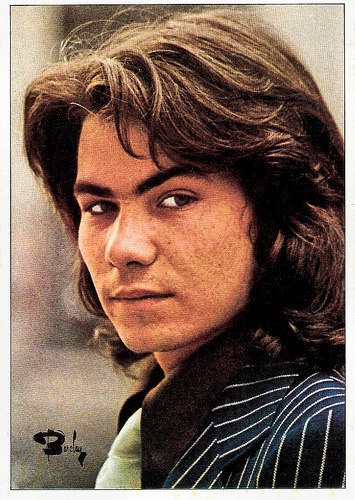
French collectors card by Figurine Panini in the Hit Collection Series, no. 61. Photo: Barclay.

French postcard by Editions Lyna, Paris, no. 2046. Photo: Laurent Maous / Production KUKLOS.
The Tenderness
Daniel Guichard was born in Sauvian, France, in 1948. He grew up in the Halles district of Paris. His father died when Daniel was 15 and to support the family income he went to work in the Halles unloading vegetables and cheeses.
In the evenings, he started to pursue a musical career. He performed in the cabarets of Montmartre and Saint-Germain-des-Prés, interpreting, songs of Aristide Bruant accompanied by an accordionist. In 1967, he recorded some of these songs for Barclay.
His real success started in 1972 with the song La Tendresse (The Tenderness), written by Patricia Carli, which became one of the classics of the French Chanson. The song was first proposed to Mireille Mathieu, but was denied by her agent Johnny Stark.
In 1972, Guichard also made his debut at the Olympia, the main French Music Hall. There followed more hits like Faut pas pleurer comme (Don’t cry like that) composed by Christophe, and the inevitable Mon Vieux (My old, 1974), dedicated to his late father, and composed by Jean Ferrat.
In 1974, Daniel Guichard recorded the songs of Edith Piaf , in which he showed his Parisian identity. In 1975 and 1976, he performed again at the Olympia. He also launched his own Kuklos label in 1975. In 1983, he was very successful with the chansons Le Gitan (The gypsy), Doucement (Softly) and Le Nez au mur (The Nose to the Wall). In his garden, he started a pirate radio station, Radio Bocal (Fishbowl), which broadcasted French chansons round the clock with a largely volunteer team.
From the late 1980s on, his records were not successful and times got tough for Guichard. In the new century, many Golden Oldies of the 1970s had a revival and Guichard returned. He went on tour again and in 2012, after 20 years of absence, he released a new album, Notre Histoire (Our Story). The album was a success. That year, he also returned to the stage of the Olympia.
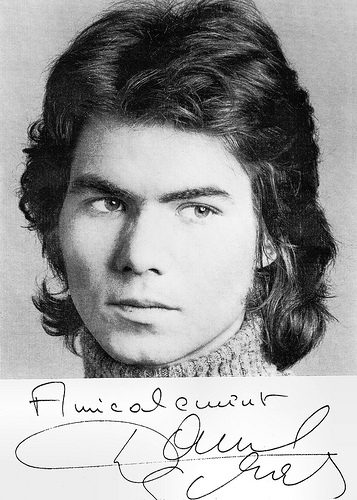
French postcard by La Roue Tourne, Paris.
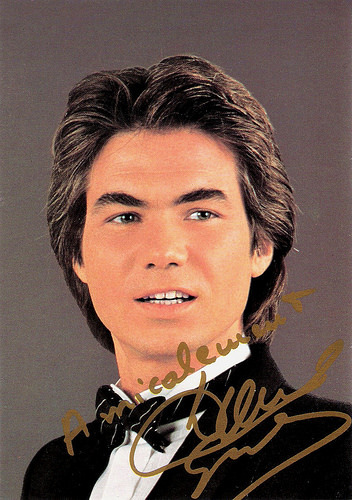
French postcard by Club Daniel Guichard, Nanterre / Imp. IP, Paris. Photo: Studio Inter-Flash.
What a Flash!
Daniel Guichard had a minor but interesting film career.
During his heydays he appeared in What a Flash! (Jean-Michel Barjol, 1972), a French alternative ‘documentary’ on the post-1968- flower-power generation. About 40 people, including well-known actors like Bernadette Lafont and Maria Schneider, enter a big hall, presumably a film studio. The doors are closed and they are to remain here for 50 hours to interact, discuss, eat, drink, sleep, ‘create’ – whatever they feel like.
Thorsten B at IMDb : “There is never a second of doubt that each of the ‘acting’ sequences included in the film are something different than the uncontrolled and spontaneous reactions and interactions before and afterward. Some of the guys and gals want to use the setting to display revolt, some play games, some try to rule, some want to obey; but in the end, the hall door opens, all step outside and everyone is happy. But subjective descriptions don't work well with this oddity. It's many things at once: interesting, yet sometimes boring; disappointing, yet sometimes suspenseful; unsurprising, yet sometimes awesome. In short, annoying, but at the same time fascinating.”
In 2014 he returned to the big screen in a supporting part in the French film Bon rétablissement!/Get Well Soon (Jean Becker, 2014) about a misanthropic and lonely grouch ( Gérard Lanvin ) who finds himself in hospital after a car accident. James Travers at Films de France : “The film is as predictable as it is anodyne but, thanks to some superb casting choices, Becker deftly avoids an outright disaster and the film is as pleasant a timewaster as you could ask for.”
Daniel Guichard has seven children from three relationships. With his former girlfriend Claudine, he has two daughters Ganaëlle (1969) and Armelle (1974) and a son, Anaël (1976) were born. From his relationship with his second girlfriend Michèle comes his daughter Emmanuelle (1984). Since 1986, he lives with Christine, with whom he has three children, Gabriël (1989), Joël (1993) and Raphaël (1996).
Daniel Guichard sings La Tendresse. Source: celib13015's channel (YouTube).
Daniel Guichard sings Mon Vieux. Source: Daniel Guichard (YouTube).
French trailer for Bon rétablissement!/Get Well Soon (2014). Source: michael cellier (YouTube). Guichard does not appear in the trailer.
Sources: James Travers (Films de France), Thorsten B (IMDb), Wikipedia (French) and .

French collectors card by Figurine Panini in the Hit Collection Series, no. 61. Photo: Barclay.

French postcard by Editions Lyna, Paris, no. 2046. Photo: Laurent Maous / Production KUKLOS.
The Tenderness
Daniel Guichard was born in Sauvian, France, in 1948. He grew up in the Halles district of Paris. His father died when Daniel was 15 and to support the family income he went to work in the Halles unloading vegetables and cheeses.
In the evenings, he started to pursue a musical career. He performed in the cabarets of Montmartre and Saint-Germain-des-Prés, interpreting, songs of Aristide Bruant accompanied by an accordionist. In 1967, he recorded some of these songs for Barclay.
His real success started in 1972 with the song La Tendresse (The Tenderness), written by Patricia Carli, which became one of the classics of the French Chanson. The song was first proposed to Mireille Mathieu, but was denied by her agent Johnny Stark.
In 1972, Guichard also made his debut at the Olympia, the main French Music Hall. There followed more hits like Faut pas pleurer comme (Don’t cry like that) composed by Christophe, and the inevitable Mon Vieux (My old, 1974), dedicated to his late father, and composed by Jean Ferrat.
In 1974, Daniel Guichard recorded the songs of Edith Piaf , in which he showed his Parisian identity. In 1975 and 1976, he performed again at the Olympia. He also launched his own Kuklos label in 1975. In 1983, he was very successful with the chansons Le Gitan (The gypsy), Doucement (Softly) and Le Nez au mur (The Nose to the Wall). In his garden, he started a pirate radio station, Radio Bocal (Fishbowl), which broadcasted French chansons round the clock with a largely volunteer team.
From the late 1980s on, his records were not successful and times got tough for Guichard. In the new century, many Golden Oldies of the 1970s had a revival and Guichard returned. He went on tour again and in 2012, after 20 years of absence, he released a new album, Notre Histoire (Our Story). The album was a success. That year, he also returned to the stage of the Olympia.

French postcard by La Roue Tourne, Paris.

French postcard by Club Daniel Guichard, Nanterre / Imp. IP, Paris. Photo: Studio Inter-Flash.
What a Flash!
Daniel Guichard had a minor but interesting film career.
During his heydays he appeared in What a Flash! (Jean-Michel Barjol, 1972), a French alternative ‘documentary’ on the post-1968- flower-power generation. About 40 people, including well-known actors like Bernadette Lafont and Maria Schneider, enter a big hall, presumably a film studio. The doors are closed and they are to remain here for 50 hours to interact, discuss, eat, drink, sleep, ‘create’ – whatever they feel like.
Thorsten B at IMDb : “There is never a second of doubt that each of the ‘acting’ sequences included in the film are something different than the uncontrolled and spontaneous reactions and interactions before and afterward. Some of the guys and gals want to use the setting to display revolt, some play games, some try to rule, some want to obey; but in the end, the hall door opens, all step outside and everyone is happy. But subjective descriptions don't work well with this oddity. It's many things at once: interesting, yet sometimes boring; disappointing, yet sometimes suspenseful; unsurprising, yet sometimes awesome. In short, annoying, but at the same time fascinating.”
In 2014 he returned to the big screen in a supporting part in the French film Bon rétablissement!/Get Well Soon (Jean Becker, 2014) about a misanthropic and lonely grouch ( Gérard Lanvin ) who finds himself in hospital after a car accident. James Travers at Films de France : “The film is as predictable as it is anodyne but, thanks to some superb casting choices, Becker deftly avoids an outright disaster and the film is as pleasant a timewaster as you could ask for.”
Daniel Guichard has seven children from three relationships. With his former girlfriend Claudine, he has two daughters Ganaëlle (1969) and Armelle (1974) and a son, Anaël (1976) were born. From his relationship with his second girlfriend Michèle comes his daughter Emmanuelle (1984). Since 1986, he lives with Christine, with whom he has three children, Gabriël (1989), Joël (1993) and Raphaël (1996).
Daniel Guichard sings La Tendresse. Source: celib13015's channel (YouTube).
Daniel Guichard sings Mon Vieux. Source: Daniel Guichard (YouTube).
French trailer for Bon rétablissement!/Get Well Soon (2014). Source: michael cellier (YouTube). Guichard does not appear in the trailer.
Sources: James Travers (Films de France), Thorsten B (IMDb), Wikipedia (French) and .
Published on April 24, 2016 22:00
April 23, 2016
Paul Capellani
With his brooding good looks, stage and film actor Paul Capellani (1877-1960) became a successful star of some 100 French and American films between 1908 and 1930. He was the younger brother of noted film director Albert Capellani and he appeared in many of his brother’s silent historical films.
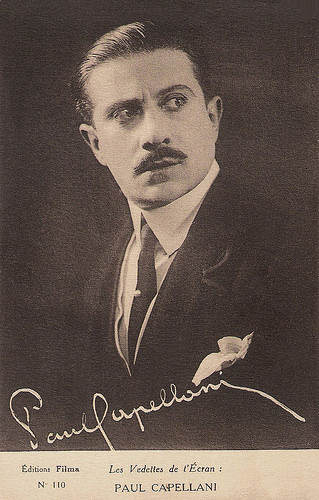
French postcard in the Les Vedettes de l'Écran series by Editions Filma, no. 110.
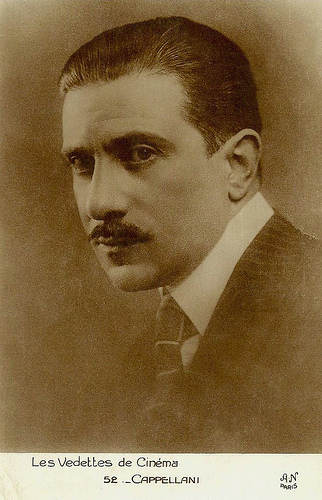
French postcard in the Les Vedettes de Cinema series by A.N., Paris, no. 52.
Jeune Premier
Born in Paris in 1877 (some sources say 1873), Paul Henri Capellani studied at the Conservatoire (the Paris Conservatory). With his good looks and small moustache he soon became one of the most popular jeunes premiers of the French theatre of the Belle Epoque.
At the zenith of his theatrical success, his older brother Albert Capellani called him in 1908 to act in his films for the Société Cinématographique des Auteurs et Gens de Lettres (SCAGL), a subsection of Pathé Frères which focused on adaptations of famous French stage plays.
Capellani thus played in short silent film adaptations like L’Arlésienne (Albert Capellani. 1908) by Alphonse Daudet, L’Assommoir/Drink (Albert Capellani, 1908) by Émile Zola, La tour de Nesle/The Tower of Nesle (Albert Capellani, 1909) by Alexandre Dumas pére, La peau de chagrin/The Wild Ass's Skin (Albert Capellani, 1909) by Honoré de Balzac, and Hernani (Albert Capellani, 1910) by Victor Hugo.
He played opposite such stars of the new medium as Stacia Napierkowska , Francesca Bertini and Gabrielle Rosny. From 1910 on, Paul continued to work with his brother but alternated with films by other French film directors of the 1910s, such as George Denola, Ferdinand Zecca, Georges Monca, André Calmettes and Camille de Morlhon.
In 1911 Paul Capellani also worked as scriptwriter, adapting Hugo’s Les Misérables. The four-part serial Les Misérables (Albert Capellani, 1913) starred Henry Krauss as Jean Valjean, and Mistinguett as Eponine Thénardier. It was probably the first feature on which Paul collaborated, but it also marked the passage from onereelers to feature-length films in French cinema at large.
He played more memorable leading acting roles in Les Mystères de Paris/The Mysteries of Paris (Albert Capellani, 1912), La maison du baigneur/The House of the Swimmer (Adrien Caillard, Albert Capellani, 1913) with Gabriel de Gravone , La Glu/The Birdlime (Albert Capellani, 1913) starring Mistinguett , Germinal (Albert Capellani, 1913), and Patrie/Homeland (Albert Capellani, 1914).
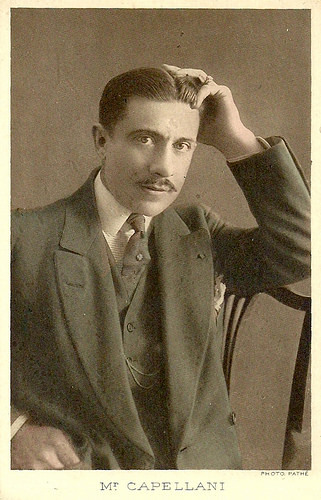
French postcard. Photo: Pathé.
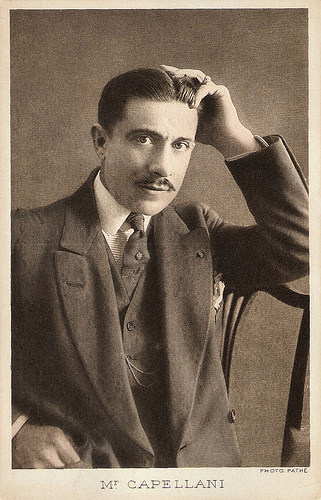
French postcard by Platinogravure. Photo: Pathé.
To the United States
When the First World War broke out, the French film industry slowed down and the two Capellani brothers went to the United States. When Clara Kimball Young formed her own company, she hired Paul Capellani to co-star in several films of European inspiration, often directed by Albert.
Paul’s first role was that of Armand Duval in the adaptation of Alexandre Dumas fils’ play La dame aux camellias/Camille (Albert Capellani, 1915), with Kimball Young as the unfortunate title character. Scriptwriter was the later famous Frances Marion. Kimball Young and Capellani were again paired in The Feast of Life (1916), The Dark Silence (1916), The Foolish Virgin (1916), and The Common Law (1916); all directed by Albert Capellani.
During his stay in the US, Paul Capellani also played opposite Alice Brady in La vie de Bohème/La Bohème (Albert Capellani, 1916), Frances Marion’s adaptation of Henry Murger’s novel; opposite Rita Jolivet in One Law for Both (Ivan Abramson, 1916); and opposite Anna Murdock in The Richest Girl (Albert Capellani, 1918).
After the war, Capellani returned to France, where he played in Marcel L’Herbier’s Le bercail (1919) starring Jaque Catelain , in L’étau/The vice (Maurice Mariaud, 1920), Le carnaval des vérités/The carnival of the truths (Marcel L’Herbier, 1920), André Antoine’s Hugo adaptation Quatre-vingt-treize (1921), and Suzanne et les brigands/Suzanne and the Bandits (Charles Burguet), 1921 with Suzanne Grandais.
In 1922 Capellani played in Phroso (Louis Mercanton, 1922), about an Englishman (Reginald Owen) who purchases an island where a mysterious woman (Malvina Longfellow) rules. Other actors were Capellani’s wife Jeanne Desclos and a young Charles Vanel.
After 1922, Paul Capellani hardly did films anymore, and focused on sculpting. His last roles were parts in two early French Paramount sound films: La lettre/The letter (Louis Mercanton, 1930) based on a play by Somerset Maugham and scripted by Monta Bell, and the male lead in Une femme a menti/A Woman has lied (Charles de Rochefort, 1930).
After the death of his brother Albert in 1931, Paul quitted acting altogether and withdrew to the Cote d’Azur. There he died in Cagnes-sur-Mer in 1960, at the age of 83. At the time of his death Paul Capellani was completely forgotten, despite his brilliant film career. His former co-star Clara Kimball-Young remembered him fondly: "of all the screen lovers I have had, I really believe I prefer Paul Capellani, who played Armand to my Camille. Of course, Mr. Capellani had all the advantages in the world, for Armand is a wonderful role, and should inspire any man who has the least germ of talent for lovemaking. But in addition to that he has the foreign--perhaps I should say the latin technique."
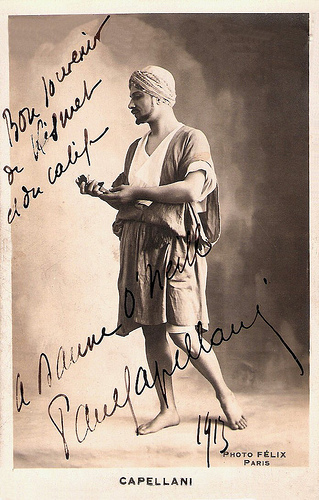
French postcard. Photo: Félix, Paris. Signed in 1913.
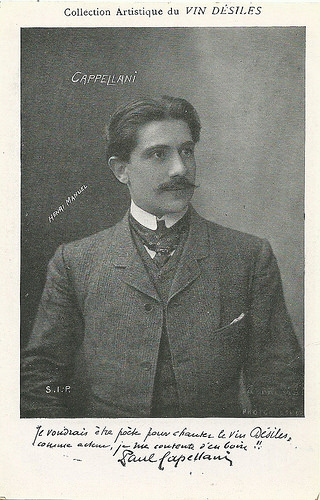
French postcard. Publicity for Vins Désiles. Photo: Henri Manuel.Photo: Henri Manuel. NB Capellani's name is mispelled on the card. Caption: "Je voudrais être poète pour chanter le vin Désiles, comme acteur, je me contente d'en boire." [I wish I was a poet so I could hymn Désiles wine, as actor I am content to just drink it.]
Sources: Clara Kimball Young (Photoplay, March, 1920), Eric Le Roy (Encyclopedia of Early Cinema), Philippe Pelletier (CinéArtistes, French), Wikipedia and .

French postcard in the Les Vedettes de l'Écran series by Editions Filma, no. 110.

French postcard in the Les Vedettes de Cinema series by A.N., Paris, no. 52.
Jeune Premier
Born in Paris in 1877 (some sources say 1873), Paul Henri Capellani studied at the Conservatoire (the Paris Conservatory). With his good looks and small moustache he soon became one of the most popular jeunes premiers of the French theatre of the Belle Epoque.
At the zenith of his theatrical success, his older brother Albert Capellani called him in 1908 to act in his films for the Société Cinématographique des Auteurs et Gens de Lettres (SCAGL), a subsection of Pathé Frères which focused on adaptations of famous French stage plays.
Capellani thus played in short silent film adaptations like L’Arlésienne (Albert Capellani. 1908) by Alphonse Daudet, L’Assommoir/Drink (Albert Capellani, 1908) by Émile Zola, La tour de Nesle/The Tower of Nesle (Albert Capellani, 1909) by Alexandre Dumas pére, La peau de chagrin/The Wild Ass's Skin (Albert Capellani, 1909) by Honoré de Balzac, and Hernani (Albert Capellani, 1910) by Victor Hugo.
He played opposite such stars of the new medium as Stacia Napierkowska , Francesca Bertini and Gabrielle Rosny. From 1910 on, Paul continued to work with his brother but alternated with films by other French film directors of the 1910s, such as George Denola, Ferdinand Zecca, Georges Monca, André Calmettes and Camille de Morlhon.
In 1911 Paul Capellani also worked as scriptwriter, adapting Hugo’s Les Misérables. The four-part serial Les Misérables (Albert Capellani, 1913) starred Henry Krauss as Jean Valjean, and Mistinguett as Eponine Thénardier. It was probably the first feature on which Paul collaborated, but it also marked the passage from onereelers to feature-length films in French cinema at large.
He played more memorable leading acting roles in Les Mystères de Paris/The Mysteries of Paris (Albert Capellani, 1912), La maison du baigneur/The House of the Swimmer (Adrien Caillard, Albert Capellani, 1913) with Gabriel de Gravone , La Glu/The Birdlime (Albert Capellani, 1913) starring Mistinguett , Germinal (Albert Capellani, 1913), and Patrie/Homeland (Albert Capellani, 1914).

French postcard. Photo: Pathé.

French postcard by Platinogravure. Photo: Pathé.
To the United States
When the First World War broke out, the French film industry slowed down and the two Capellani brothers went to the United States. When Clara Kimball Young formed her own company, she hired Paul Capellani to co-star in several films of European inspiration, often directed by Albert.
Paul’s first role was that of Armand Duval in the adaptation of Alexandre Dumas fils’ play La dame aux camellias/Camille (Albert Capellani, 1915), with Kimball Young as the unfortunate title character. Scriptwriter was the later famous Frances Marion. Kimball Young and Capellani were again paired in The Feast of Life (1916), The Dark Silence (1916), The Foolish Virgin (1916), and The Common Law (1916); all directed by Albert Capellani.
During his stay in the US, Paul Capellani also played opposite Alice Brady in La vie de Bohème/La Bohème (Albert Capellani, 1916), Frances Marion’s adaptation of Henry Murger’s novel; opposite Rita Jolivet in One Law for Both (Ivan Abramson, 1916); and opposite Anna Murdock in The Richest Girl (Albert Capellani, 1918).
After the war, Capellani returned to France, where he played in Marcel L’Herbier’s Le bercail (1919) starring Jaque Catelain , in L’étau/The vice (Maurice Mariaud, 1920), Le carnaval des vérités/The carnival of the truths (Marcel L’Herbier, 1920), André Antoine’s Hugo adaptation Quatre-vingt-treize (1921), and Suzanne et les brigands/Suzanne and the Bandits (Charles Burguet), 1921 with Suzanne Grandais.
In 1922 Capellani played in Phroso (Louis Mercanton, 1922), about an Englishman (Reginald Owen) who purchases an island where a mysterious woman (Malvina Longfellow) rules. Other actors were Capellani’s wife Jeanne Desclos and a young Charles Vanel.
After 1922, Paul Capellani hardly did films anymore, and focused on sculpting. His last roles were parts in two early French Paramount sound films: La lettre/The letter (Louis Mercanton, 1930) based on a play by Somerset Maugham and scripted by Monta Bell, and the male lead in Une femme a menti/A Woman has lied (Charles de Rochefort, 1930).
After the death of his brother Albert in 1931, Paul quitted acting altogether and withdrew to the Cote d’Azur. There he died in Cagnes-sur-Mer in 1960, at the age of 83. At the time of his death Paul Capellani was completely forgotten, despite his brilliant film career. His former co-star Clara Kimball-Young remembered him fondly: "of all the screen lovers I have had, I really believe I prefer Paul Capellani, who played Armand to my Camille. Of course, Mr. Capellani had all the advantages in the world, for Armand is a wonderful role, and should inspire any man who has the least germ of talent for lovemaking. But in addition to that he has the foreign--perhaps I should say the latin technique."

French postcard. Photo: Félix, Paris. Signed in 1913.

French postcard. Publicity for Vins Désiles. Photo: Henri Manuel.Photo: Henri Manuel. NB Capellani's name is mispelled on the card. Caption: "Je voudrais être poète pour chanter le vin Désiles, comme acteur, je me contente d'en boire." [I wish I was a poet so I could hymn Désiles wine, as actor I am content to just drink it.]
Sources: Clara Kimball Young (Photoplay, March, 1920), Eric Le Roy (Encyclopedia of Early Cinema), Philippe Pelletier (CinéArtistes, French), Wikipedia and .
Published on April 23, 2016 22:00
Paul van Yperen's Blog
- Paul van Yperen's profile
- 13 followers
Paul van Yperen isn't a Goodreads Author
(yet),
but they
do have a blog,
so here are some recent posts imported from
their feed.



